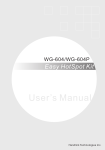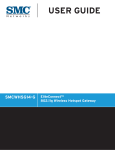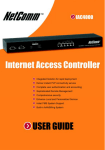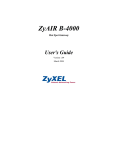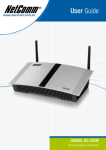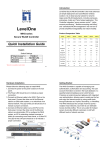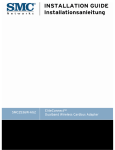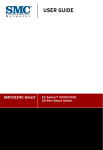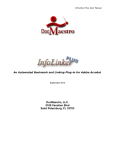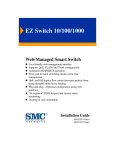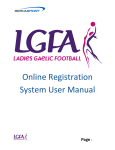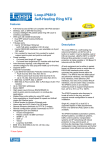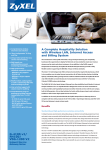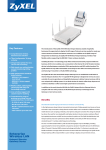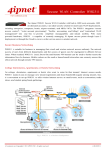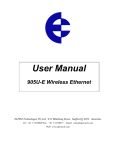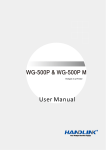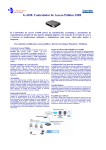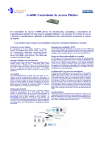Download User`s Manual - Edge-Core
Transcript
USER GUIDE
SMCWHSG14-G
EliteConnect™
802.11g Wireless Hotspot Gateway
SMCWHSG14-G
User Guide
Copyright Notice
Copyright © 2005-2015 SMC NETWORKS Inc. All rights reserved. No part of this document may be
copied, reproduced, or transmitted by any means, for any purpose without prior written permission.
Disclaimer
We shall not be liable for technical or editorial errors or omissions contained herein; nor for incidental or
consequential damages resulting from furnishing this material, or the performance or use of this
product. We reserve the right to change the product specification without notice. Information in this
document may change without notice.
Trademarks
Microsoft Win98, Windows 2000 and WinXP are registered trademarks of Microsoft Corporation.
General: All other brand and product names mentioned herein may be registered trademarks of their
respective owners. Customers should ensure that their use of this product does not infringe upon any
patent rights. Trademarks mentioned in this publication are used for identification purposes only and
are properties of their respective companies.
2
SMCWHSG14-G
SMC's Limited Warranty
Limited Warranty Statement: SMC Networks, Inc. ("SMC") warrants its products to be free from defects
in workmanship and materials, under normal use and service, for the applicable warranty term. All SMC
products carry a standard 90-day limited warranty from the date of purchase from SMC or its Authorized
Reseller. SMC may, at its own discretion, repair or replace any product not operating as warranted with a
similar or functionally equivalent product, during the applicable warranty term. SMC will endeavor to
repair or replace any product returned under warranty within 30 days of receipt of the product.
The standard limited warranty can be upgraded to a Limited Lifetime* warranty by registering new
products within 30 days of purchase from SMC or its Authorized Reseller. Registration can be
accomplished via the enclosed product registration card or online via the SMC web site. Failure to
register will not affect the standard limited warranty. The Limited Lifetime warranty covers a product
during the Life of that Product, which is defined as the period of time during which the product is an
'Active' SMC product. A product is considered to be 'Active' while it is listed on the current SMC price list.
As new technologies emerge, older technologies become obsolete and SMC will, at its discretion, replace
an older product in its product line with one that incorporates these newer technologies. At that point,
the obsolete product is discontinued and is no longer an 'Active' SMC product.
All products that are replaced become the property of SMC. Replacement products may be either new or
reconditioned. Any replaced or repaired product carries either a 30-day limited warranty or the
remainder of the initial warranty, whichever is longer. SMC is not responsible for any custom software or
firmware, configuration information, or memory data of Customer contained in, stored on, or integrated
with any products returned to SMC pursuant to any warranty. Products returned to SMC should have any
customer-installed accessory or add-on components, such as expansion modules, removed prior to
returning the product for replacement. SMC is not responsible for these items if they are returned with
the product.
3
SMCWHSG14-G
Customers must contact SMC for a Return Material Authorization number prior to returning any product
to SMC. Proof of purchase may be required. Any product returned to SMC without a valid Return Material
Authorization (RMA) number clearly marked on the outside of the package will be returned to customer
at customer's expense. For warranty claims within North America, please call our toll-free customer
support number at (800) 762-4968. Customers are responsible for all shipping charges from their facility
to SMC. SMC is responsible for return shipping charges from SMC to customer.
WARRANTIES EXCLUSIVE: IF AN SMC PRODUCT DOES NOT OPERATE AS WARRANTED ABOVE,
CUSTOMER'S SOLE REMEDY SHALL BE REPAIR OR REPLACEMENT OF THE PRODUCT IN QUESTION, AT
SMC'S OPTION. THE FOREGOING WARRANTIES AND REMEDIES ARE EXCLUSIVE AND ARE IN LIEU OF
ALL OTHER WARRANTIES OR CONDITIONS, EXPRESS OR IMPLIED, EITHER IN FACT OR BY
OPERATION OF LAW, STATUTORY OR OTHERWISE, INCLUDING WARRANTIES OR CONDITIONS OF
MERCHANTABILITY AND FITNESS FOR A PARTICULAR PURPOSE. SMC NEITHER ASSUMES NOR
AUTHORIZES ANY OTHER PERSON TO ASSUME FOR IT ANY OTHER LIABILITY IN CONNECTION WITH
THE SALE, INSTALLATION, MAINTENANCE OR USE OF ITS PRODUCTS. SMC SHALL NOT BE LIABLE
UNDER THIS WARRANTY IF ITS TESTING AND EXAMINATION DISCLOSE THE ALLEGED DEFECT IN THE
PRODUCT DOES NOT EXIST OR WAS CAUSED BY CUSTOMER'S OR ANY THIRD PERSON'S MISUSE,
NEGLECT, IMPROPER INSTALLATION OR TESTING, UNAUTHORIZED ATTEMPTS TO REPAIR, OR ANY
OTHER CAUSE BEYOND THE RANGE OF THE INTENDED USE, OR BY ACCIDENT, FIRE, LIGHTNING, OR
OTHER HAZARD.
LIMITATION OF LIABILITY: IN NO EVENT, WHETHER BASED IN CONTRACT OR TORT (INCLUDING
NEGLIGENCE), SHALL SMC BE LIABLE FOR INCIDENTAL, CONSEQUENTIAL, INDIRECT, SPECIAL, OR
PUNITIVE DAMAGES OF ANY KIND, OR FOR LOSS OF REVENUE, LOSS OF BUSINESS, OR OTHER
FINANCIAL LOSS ARISING OUT OF OR IN CONNECTION WITH THE SALE, INSTALLATION,
MAINTENANCE, USE, PERFORMANCE, FAILURE, OR INTERRUPTION OF ITS PRODUCTS, EVEN IF SMC
OR ITS AUTHORIZED RESELLER HAS BEEN ADVISED OF THE POSSIBILITY OF SUCH DAMAGES.
4
SMCWHSG14-G
SOME STATES DO NOT ALLOW THE EXCLUSION OF IMPLIED WARRANTIES OR THE LIMITATION OF
INCIDENTAL OR CONSEQUENTIAL DAMAGES FOR CONSUMER PRODUCTS, SO THE ABOVE
LIMITATIONS AND EXCLUSIONS MAY NOT APPLY TO YOU. THIS WARRANTY GIVES YOU SPECIFIC
LEGAL RIGHTS, WHICH MAY VARY FROM STATE TO STATE. NOTHING IN THIS WARRANTY SHALL BE
TAKEN TO AFFECT YOUR STATUTORY RIGHTS.
* SMC will provide warranty service for one year following discontinuance from the active SMC price list.
Under the limited lifetime warranty, internal and external power supplies, fans, and cables are covered
by a standard one-year warranty from date of purchase.
5
SMCWHSG14-G
Table of Contents
1. Introduction...................................................................................................................................... 4
1-1 Package Contents ......................................................................................................................... 4
1-2 Features ........................................................................................................................................ 5
1-3 Precautions.................................................................................................................................... 5
1-4 Outlook .......................................................................................................................................... 5
1-4-1
Top Panel .......................................................................................................................... 6
1-4-2
Rear Panel ........................................................................................................................ 7
1-5 Technical Specifications................................................................................................................. 8
1-5-1
Hardware Specifications.................................................................................................... 8
1-5-2
Software Specifications ................................................................................................... 10
2. Installation...................................................................................................................................... 12
2-1 Wall-mounting.............................................................................................................................. 12
2-2 Connecting the Antennas ............................................................................................................ 13
2-3 Installation Requirements ............................................................................................................ 13
2-4 Getting Start................................................................................................................................. 15
2-5 POE Application........................................................................................................................... 16
3. Configuring the Wireless Subscriber Gateway .......................................................................... 17
3-1 Setting Wizard ............................................................................................................................. 17
3-2 Advanced Setup .......................................................................................................................... 41
3-2-1
System ............................................................................................................................ 42
3-2-2
WAN/LAN ........................................................................................................................ 45
3-2-3
Server.............................................................................................................................. 52
3-2-4
Authentication ................................................................................................................. 54
3-2-5
RADIUS Authentication ................................................................................................... 57
3-2-6
Billing............................................................................................................................... 60
3-2-7
Accounting ...................................................................................................................... 66
3-2-8
Credit Card ...................................................................................................................... 79
3-2-9
Keypad ............................................................................................................................ 86
3-2-10 Customization ................................................................................................................. 94
3-2-11 Pass Through ................................................................................................................ 120
3-2-12 Filtering ......................................................................................................................... 122
3-2-13 Share............................................................................................................................. 124
3-2-14 Portal Page.................................................................................................................... 125
3-2-15 Advertisement ............................................................................................................... 126
3-2-16 Walled Garden .............................................................................................................. 127
6
SMCWHSG14-G
3-2-17 DDNS ............................................................................................................................ 129
3-2-18 LAN Devices ................................................................................................................. 131
3-2-19 Syslog ........................................................................................................................... 133
3-2-20 Session Trace ............................................................................................................... 140
3-2-21 Bandwidth...................................................................................................................... 141
3-2-22 Secure Remote ............................................................................................................. 142
3-2-23 SNMP ............................................................................................................................ 143
3-2-24 Wireless ........................................................................................................................ 145
3-2-25 MISCELLANEA ............................................................................................................. 149
3-3 System Status............................................................................................................................ 150
3-3-1
System .......................................................................................................................... 151
3-3-2
Account List................................................................................................................... 153
3-3-3
Account Log .................................................................................................................. 154
3-3-4
Current User.................................................................................................................. 155
3-3-5
DHCP Client .................................................................................................................. 156
3-3-6
Session List................................................................................................................... 156
3-3-7
LAN Devices ................................................................................................................. 157
3-4 System Tools ............................................................................................................................. 157
3-4-1
Configuration ................................................................................................................. 158
3-4-2
Firmware Upgrade ........................................................................................................ 159
3-4-3
Boot Code ..................................................................................................................... 161
3-4-4
System Account ............................................................................................................ 161
3-4-5
SSL Certificate .............................................................................................................. 166
3-4-6
Ping Command ............................................................................................................. 167
3-4-7
Restart........................................................................................................................... 167
3-4-8
Logout ........................................................................................................................... 167
Appendix A. RJ-45 Connector Description ........................................................................................ 168
Appendix B. Regulations/EMI Compliance........................................................................................ 169
SMCWHSG14-G
7
1. Introduction
The Wireless Subscriber Gateway is a compact intelligent gateway integrated with a four-port
port-based VLAN switch. It provides Plug’ Play Internet access, advanced security and network
management.
The Wireless Subscriber Gateway is designed for service providers, system integrator or hotspot venue
operator without backend-RADIUS-Server to have integrated solution for rapid deployment, which can
start hotspot service quickly and easily and enhance service performance.
The Wireless Subscriber Gateway is an ideal solution for hotel lobbies, coffee bars, airport lounges,
conference facilities and other sites that commonly host business travelers, and offers instant
high-speed Internet connections. With its IP Plug and Play technology, it accepts any client
configuration login, when client open browser the Wireless Subscriber Gateway immediately
recognizes new end-user and redirects their browser to customized Web pages. There’s no need for
end-user to change any of their default network (Static IP), e-mail (SMTP Server behind firewall), or
browser settings (HTTP Proxy) or load any special software to access hotspot service. It’s completely
Plug’ Play with any browser.
1-1 Package Contents
Please inspect your package. The following items should be included:
◎ SMCWHSG14-G
z One Wireless Subscriber Gateway
z Two antennas
z One AC Power Adapter for Wireless Subscriber Gateway
z One CD containing User’s Manual and MIB file
z Two screws for wall-mount
z One UTP Ethernet/Fast Ethernet cable (Cat.5 Twisted-pair)
Optional Product:
◎ AG-200E Account Generator Printer
z One AC Power Adapter for mini account generator printer
z One UTP Ethernet/Fast Ethernet cable (Cat.5 Twisted-pair)
z One Account Generator Printer User’s Guide
If any of the above items are damaged or missing, please contact your dealer immediately.
8
SMCWHSG14-G
1-2 Features
z Wireless data rates up to 54Mbps
z Supports 100 Simultaneous Users
z IP Plug and Play (iPnP)
z Comprehensive security
64/128-bit WEP encryption
WPA encryption
IP/URL filtering
z Intelligent Management
z Built-in AAA (Authentication/Accounting/Authorization) and Billing mechanism
Note: The "PnP" Function only can be used with TCP/IP-based Network.
1-3 Precautions
z Never remove or open the cover. You may suffer serious injury if you touch these parts.
z Never install the system in the wet locations.
z Use only the original fitting AC power adapter otherwise there is a danger of severe electrical shock.
z Avoid exposing the Wireless Subscriber Gateway to direct sunlight or another heat source.
z Choose a well-ventilated area to position your Wireless Subscriber Gateway.
1-4 Outlook
Figure 1-1 Wireless Subscriber Gateway Outlook
SMCWHSG14-G
9
1-4-1 Top Panel
The top panel of the Wireless Subscriber Gateway is shown below.
Figure 1-2 Wireless Subscriber Gateway Top Panel
10
SMCWHSG14-G
LEDs Indication
LED
State
Description
POWER
Off
The Wireless Subscriber Gateway is not receiving electrical power.
Green
The Wireless Subscriber Gateway is receiving electrical power.
Off
The Wireless Subscriber Gateway status is defective.
Green
The Wireless Subscriber Gateway status is complete.
SYS
Green (Blinking) During firmware upgrades, this system LED will blink.
WAN
Off
Port has not established any network connection.
Green
A port has established a valid 10/100Mbps network connection.
Green (Blinking) 10/100Mbps traffic is traversing the port.
LAN-1~
Off
Port has not established any network connection.
LAN-4
Green
A port has established a valid 10/100Mbps network connection.
Green (Blinking) 10/100Mbps traffic is traversing the port.
WLAN
Off
The Wireless is not ready.
Green
The Wireless Subscriber Gateway has established a valid wireless
connection.
Green (Blinking) The Wireless connection is active.
1-4-2 Rear Panel
The rear panel of the Wireless Subscriber Gateway is shown below.
Figure 1-4 Wireless Subscriber Gateway Rear Panel
SMCWHSG14-G
11
1. RS-232: Reserve for manufacture use.
2. LAN (1-4):
The rear panel supports four auto-sensing RJ-45 ports and all ports can be auto-switched to MDI-II
connections. The LAN ports used for linking hosts or other network devices. The individual port can be
either connected to 100BaseTX networks or 10BaseT networks. When connecting to a 100BaseTX
network, the ports operate at 100Mbps in half-duplex mode or 200Mbps in full-duplex mode. When
connecting to a 10BaseT network, the ports operate at 10Mbps in half-duplex mode or 20Mbps in
full-duplex mode.
3. WAN: One Ethernet port used for linking xDSL or Cable Modem.
4. Reset Button:
The Wireless Subscriber Gateway has a reset button at the rear panel of the device. Use this function
to reset the system back to factory defaults.
5. Power Jack: Used to connect the external power supply with the Wireless Subscriber Gateway.
1-5 Technical Specifications
1-5-1 Hardware Specifications
Network Specification
IEE802.3 10BaseT Ethernet
IEE802.3u 100BaseTX Fast Ethernet
IEE802.11g Wireless LAN
IEEE802.3af Power over Ethernet
ANSI/IEEE 802.3 NWay auto-negotiation
Wi-Fi Compatible
Connectors
One Printer Port (1 DB9 DTE male connector for Account Generator Printer)
Four LAN Ports (10BaseT/100BaseTX Auto cross-over)
One WAN Port (10BaseT/100BaseTX Auto cross-over)
Encryption
WEP (Wired Equivalent Privacy) 64/128-bit RC4
WPA (Wi-Fi Protected Access)
External Antenna Type
2dBi (Max) Dual detachable diversity antenna with reverse SMA
12
SMCWHSG14-G
LED Indicators
One POWER LED
One WAN 10/100M Link/Activity LED
Four LAN 10M/100M Link/Activity LEDs
One Wireless Link/Activity LED
One System LED
Power Requirement
External Power Adapter
Input: 100-240 VAC, 50/60 Hz
Output: 5V, 2A
Environment Conditions
Operating Temperature: 0 to 50°C
Storage Temperature: -10 to 60°C
Operating Humidity: 10~80% non-condensing
Storage Humidity: 10% to 90% non-condensing
Certifications
FCC part 15 Class B, CE, CSA, VCCI Class B, CE / R&TTE, C-Tick
Dimension
Size: 242 (L) x 130.5 (W) x 77 (H) mm
Weight: About 420g (Net)
Mounting
Desktop, Wall mounted
SMCWHSG14-G
13
1-5-2 Software Specifications
Networking
•
IEEE802.3 10BaseT Ethernet
•
IEEE802.3u 100BaseTX Fast Ethernet
•
IEEE802.3af Power over Ethernet
•
IEEE802.11b Wireless LAN
•
IEEE802.11g Wireless LAN
•
Supports 100 Simultaneous Users
•
IP Plug and Play (iPnP)
•
HTTP Proxy Support
•
SMTP Server Redirection
•
DHCP Server
•
DHCP Relay
•
Static IP WAN Client
•
DHCP WAN Client
•
PPPoE WAN Client
•
PPTP WAN Client
•
NAT
•
NTP (Network Time Protocol) Support
•
DDNS
Marketing Cooperation
•
Advertisement URL link
•
Walled garden
•
Customizable log-on and log-off pages
•
Portal Page
•
WISPr Smart Client
User Accounting and Authentication
•
Built-in Authentication
•
Web-based Authentication
•
RADIUS AAA Support (RFC 2865, 2866)
•
Secondary RADIUS
•
User Authentication and Accounting
•
Logout Window Timer Control
14
SMCWHSG14-G
Security and Firewall
•
Layer 2 Isolation Security
•
SSL User Login page/ Configuration Page
•
SSL Administration
•
VPN Pass through (IPSec/PPTP)
•
Customize SSL Certificate
•
Pass Through IP/MAC/URL Address
•
Restricted Destination Filtering IP/URL
•
VPN (IPSec/PPTP) Pass through
•
PPTP VPN Client
•
WEP
•
WPA
Management
•
Web-based Management Tool
•
Firmware Upgrade via HTTP/TFTP
•
Wizard setup for step-by-step Configuration
•
Backup/Restore/Factory Default Setting
•
Remote Authorized Management
•
Real-time Session List
•
LAN Device Management
•
Syslog (System/Subscriber/LAN device)
•
E-mail logs
•
SNMP v1/v2 (MIB II, Private MIB)
•
System Information Table
•
Status Report (Daily/Monthly/System/Network)
•
SSL certificate upload
Extra Function with optional AG-200E
•
Local Authentication
•
Local Accounting
•
Local Billing
AG-200E Account Generator (Thermal Printer)
Interface: Ethernet
Print Width: 48mm (Paper width: 58mm)
Paper Length: 50 M
SMCWHSG14-G
15
2. Installation
The followings are instructions for setting up the Wireless Subscriber Gateway. Refer to the illustration
and follow the simple steps below to quickly install your Wireless Subscriber Gateway.
2-1
Wall-Mounting
The Wireless Subscriber Gateway can be wall-mounted on a wall by applying the two mounting
brackets on screws.
Figure 2-1 Wall-Mounting Bracket - Bottom of Wireless Subscriber Gateway
Please refer to the following instructions for mounting a Wireless Subscriber Gateway on a wall or other
surface.
1.
Install two screws on a wall according to the relative positions shown below.
Figure 2-2
2.
Hang Wireless Subscriber Gateway on the wall by sliding the two screws in the mounting
brackets.
2-1.1 Bracket-Mounting
1. Attach the brackets to the device using the screws provided in the mounting kits.
16
SMCWHSG14-G
2.Mount the device in the rack, using three rack-mountings screws.
Note: If the screws are not properly anchored, the strain of the cables connected to the Wireless
Subscriber Gateway rear panel connectors could pull out the Wireless Subscriber Gateway from
the wall.
2-2
Connecting the Antennas
The Wireless Subscriber Gateway provides two antenna connectors on the rear of the unit.
2-3
Installation Requirements
Before installing the Wireless Subscriber Gateway, make sure your network meets the following
requirements.
System Requirements
The Wireless Subscriber Gateway requires one of the following types of software:
z Windows 98 Second Edition/NT/2000/XP
z Red Hat Linux 7.3 or later version
z MAC OS X 10.2.4 or later version
z Any TCP/IP-enabled systems like Mac OS and UNIX (TCP/IP protocol installed)
z Standard phone line for xDSL modem
Or
Coaxial cable for Cable modem
z Web Browser Software (Microsoft I.E 5.0 or later version or Netscape Navigator 5.0 or later
version)
z One computer with an installed 10Mbps, 100Mbps or 10/100Mbps Ethernet card
z UTP network Cable with a RJ-45 connection (Package contents)
Note: Prepare twisted-pair cables with RJ-45 plugs. Use Cat.5 cable for all connections. Make sure
each cable not exceed 328 feet (Approximately 100 meters).
SMCWHSG14-G
17
ISP Requirements
Verify whether your ISP use fixed or dynamic IP. If it is a fixed IP, be sure to get the IP from your ISP.
For dynamic IP, which is mostly used, the PC will get the IP automatically whenever it hooks up on
the modem.
Dynamic IP
z Dynamic IP Setting
Fixed IP
z Your fixed IP address for the Wireless Subscriber Gateway
z Your subnet mask for the Wireless Subscriber Gateway
z Your default gateway IP address
z Your DNS IP address
PPPoE
z Your user name from your ISP
z Your password from your ISP
PPTP
z PPTP Server IP Address from your ISP
z PPTP Local IP address from your ISP.
z PPTP Local IP subnet mask from your ISP.
z Your user name from your ISP
z Your password from your ISP
Your PC Requirements
The Static IP settings for the PC
z Your PC’s fixed IP address
z Your PC’s subnet mask
z Your PC’s default gateway IP address
z Your PC’s primary DNS IP address
Note:
1. The gateway’s default IP address setting is “192.168.2.1”.
2. The gateway’s default subnet mask setting is “255.0.0.0”.
The Dynamic IP settings for the PC
We recommend that you leave your IP settings as automatically assigned. By default, the Wireless
Subscriber Gateway is a DHCP server, and it will give your PC the necessary IP settings.
18
SMCWHSG14-G
2-4
Getting Start
1. Place the Wireless Subscriber Gateway and AG-200E Printer on a flat work surface.
2. Connect the Ethernet cable to the Wireless Subscriber Gateway’s LAN port.
3. Connect the other end of the Ethernet cable to the AG-200E Account Generator Printer’s RJ45 port.
4. Ensure that your modem and computer are both switched on.
5. Use the supplied cable to connect the Wireless Subscriber Gateway's WAN port to the modem.
Check that the Cable/xDSL Status LED lights.
6. Connect your computer to one of the 10/100 LAN ports on the Wireless Subscriber Gateway. Check
that the LAN Port Status LED lights.
7. Configure the further parameters via a Web browser.
Figure 2-4 Wireless Subscriber Gateway Connection
SMCWHSG14-G
19
2-2 POE (Power over Ethernet) Application
Figure 2-6 POE Connection
Note: To use the WG-601’s POE feature, follow the instructions for your specific POE device.
20
SMCWHSG14-G
3. Configuring the Wireless Subscriber Gateway
3-1
Setting Wizard
Step 1: Start your browser, and then enter the factory default IP address 192.168.2.1 in your browser’s
location box. Press Enter.
Figure 3-1 Web Browser Location Field (Factory Default)
Step 2: The Wireless Subscriber Gateway configuration tools menu will appear. In the Username and
Password field, type the factory default user name admin and password smcadmin and click
Login. If you are first time setting the system, the wizard setup screen will appear. You will be
guided, step-by-step, through a basic setup procedure.
Username: admin
Password: smcadmin
Figure 3-2 Configuration Tools Menu
Figure 3-3 Wizard Setup Screen
SMCWHSG14-G
21
Figure 3-4 System Quick View
Click on reset button to clear the username and password data.
Note:
) This Web agent is best viewed with IE 5.0 or Netscape 6.0 and above browsers.
) If you would like to change the password please see Step 10.
) Username and Password can consist of up to 20 alphanumeric characters and are case sensitive.
) If for some reason your password is lost or you cannot gain access to the Wireless Subscriber
Gateway Configuration Program, please press the reset button to load the device to manufacturer
defaults.
) If the Wireless Subscriber Gateway doesn’t send packet in 5 minutes (default), the Wireless
Subscriber Gateway wills logout automatically.
) Proxy needs to set disable first when administrator accesses admin UI.
22
SMCWHSG14-G
Step 3: Internet Connection Setting
Select the appropriate Internet connection type to connect to your ISP.
Figure 3-5 Internet Connection Setting Screen
z DHCP Client
The device can work as a DHCP client. This allows the device to obtain the IP address and other
TCP/IP settings from your ISP. If your xDSL/Cable comes with this feature, please enable Use DHCP
Client.
Figure 3-6 Internet Connection Setting Screen—DHCP Client Setting
SMCWHSG14-G
23
z Static IP Setting
If Static IP Setting is selected, then this screen will appear. Enter the IP address information provided
by your ISP.
Figure 3-7 Internet Connection Setting Screen—Static IP Setting
Item
Default
Description
IP Address
0.0.0.0
Enter the IP address provided by your ISP.
Subnet Mask
0.0.0.0
Enter the subnet mask for the IP address.
Gateway IP
0.0.0.0
Enter the Gateway IP Address provided by your ISP.
Empty
Enter the primary DNS server IP address for the xDSL/Cable
Address
Primary DNS
Server
Secondary
DNS Server
connection (provided by your ISP).
Empty
Enter the secondary DNS server IP address for the xDSL/Cable
connection (provided by your ISP). If the primary DNS Server IP were
not available, meanwhile, Secondary DNS Server IP would start in the
same time.
24
SMCWHSG14-G
z PPPoE (Point-to-Point Protocol over Ethernet)
If “PPPoE” is selected, then this screen will appear. Enter the username, password and other major
fields.
Figure 3-8 Internet Connection Setting Screen—PPPoE Setting
Item
Default
Username
Empty
Password
Empty
PPP MTU Setting
1492
TCP MSS Setting
1452
Service Name
Empty
SMCWHSG14-G
Description
Enter the user name provided by your ISP. The user name can consist
of up to 80 alphanumeric characters and is case sensitive.
Enter the user password provided by your ISP. The password can
consist of up to 80 alphanumeric characters and is case sensitive.
MTU (Maximum Transfer Unit) specifies maximum transmission unit
size.
MSS (Maximum Segment Size) specifies maximum segment size.
Enter the service name provided by your ISP. The service name can
consist of up to 64 alphanumeric characters and is case sensitive.
25
Item
Default
Description
Connect on Demand and Max Idle Time
Connect on
Demand
Enable
You can configure your Wireless Subscriber Gateway to cut your
connection with your ISP after a specified period of time (Max Idle
Time). If you have been disconnected due to inactivity, Connect on
Demand enables your Wireless Subscriber Gateway to automatically
Max Idle Time
10
Minutes
re-establish your connection as soon as you attempt to access the
Internet again. If you wish to activate Connect on Demand, click the
radio button. If you want your Internet connection to remain, click the
radio button of keep alive. The Max Idle Time maximum value is 65535
minutes.
Keep alive and Redial Period
Keep alive
Disable
This option keeps your PPPoE enabled Internet access connected
Redial Period
30
indefinitely, even when it sits idle. The Redial Period maximum value is
Seconds 65535 seconds.
26
SMCWHSG14-G
z PPTP Client (Point-to-Point Tunneling Protocol)
If “PPTP” is selected, then this screen will appear. Fill out all the information provided by your ISP.
Figure 3-9 Internet Connection Setting Screen—PPTP Client Setting
Item
Default
My IP Address
Empty
My Subnet Mask
Empty
SMCWHSG14-G
Description
Enter the PPTP local IP address provided by your ISP.
Enter the PPTP local Subnet Mask IP address for the IP
address (My IP Address).
27
Item
Gateway IP Address
Default
Empty
PPTP Server IP Address Empty
Description
Enter the PPTP server Gateway IP address provided by your
ISP.
Enter the PPTP server IP address provided by your ISP.
Enter the user name provided by your ISP. The user name
Username
Empty
can consist of up to 80 alphanumeric characters and is case
sensitive.
Password
Empty
Enter the user password provided by your ISP. The password
can consist of up to 80 alphanumeric characters and is case
sensitive.
PPP MTU Setting
1460
TCP MSS Setting
1400
MTU
(Maximum
Transfer
Unit)
specifies
maximum
transmission unit size.
MSS (Maximum Segment Size) specifies maximum segment
size.
Enter the connection ID or connection name. The connection
Connection ID/Name
Empty
ID/Name can consist of up to 81 alphanumeric characters
and is case sensitive.
Connect on Demand and Max Idle Time
Connect on Demand
Enable
You can configure your Wireless Subscriber Gateway to cut
your connection with your ISP after a specified period of time
(Max Idle Time). If you have been disconnected due to
inactivity, Connect on Demand enables your Wireless
Subscriber Gateway to automatically re-establish your
Max Idle Time
10 Minutes connection as soon as you attempt to access the Internet
again. If you wish to activate Connect on Demand, click the
radio button. If you want your Internet connection to remain,
click the radio button of keep alive. The Max Idle Time
maximum value is 65535 minutes.
Keep alive and Redial Period
This option keeps your PPTP enabled Internet access
Keep alive
Disable
Redial Period
connected indefinitely, even when it sits idle. The Redial
30 Seconds Period maximum value is 65535 seconds.
28
SMCWHSG14-G
Step 4: Wireless Setting
This page allows you to define ESSID, Channel ID and WEP/WPA encryption for wireless connection.
Figure 3-10 Wireless Setting Screen
Item
ESSID
Default
Description
Wireless The ESSID is the unique name that is shared among all points in a
wireless network. It is case sensitive and must not exceed 32
characters.
Channel
SMCWHSG14-G
6
Enter the channel ID for wireless connection.
29
Step 5: E-mail Server Setting
Wireless Subscriber Gateway allows an extra Email server parameter to forward the subscriber’s
E-mail.
Figure 3-11 E-mail Service Setting Screen
Item
Default
Description
Email Server Redirect
No
Disables or enables email server redirect function. To
prevent some subscriber’s original Email server may protect
by firewall or NAT network. Wireless Subscriber Gateway
provides an extra Email server parameter to forward the
subscriber’s Email. The Wireless Subscriber Gateway not
only forwards the subscribers’ E-mail via other E-mail server
but also changes the SMTP header. The recipient of your
E-mail sees the message as if you sent it from your local
Internet Service Provide, not form the hotel or other place.
Email Server’s IP
Empty
address or Domain name
Before setting this field, please make sure the E-mail sever
relay function is opened. Enter the email server IP address
or domain name. The field must not exceed 50 characters.
SMTP Port
25
Enter the SMTP port. The SMTP port allowed range is 25 or
2500 to 2599.
30
SMCWHSG14-G
Step 6: Authentication Service Setting
Figure 3-12 Authentication Service Setting Screen
Item
Default
Description
Built-in Authentication/
No
Yes―
No Authentication
No Authentication)
Wireless Subscriber Gateway provides Built-in
Authentication for service provider to build up an
Internet service without any extra authentication
software. If Yes is selected, service provider can
generate the subscriber account inside Wireless
Subscriber
Gateway,
and
the
system
will
authenticate the subscriber login according to the
generated account.
No―
Subscriber can direct access the Internet without
enter username and password.
SMCWHSG14-G
31
Step 7: Billing Profile Setting
The function is used to setup a billing profile. A billing profile is a description of how you want to charge
your customer.
Figure 3-13 Billing Profile Setting Screen
Item
Default
Description
Service
Time to Finish Options: Time to Finish or Accumulation.
Time to Finish―
The subscriber can access Internet only one time with one account.
Once subscriber login, the pre-defined usage time will start until run
out even the subscriber stop to access the Internet before run out.
Accumulation―
The subscriber can access Internet many times with one account.
The system can keep and accumulate every single usage time until
the pre-defined usage time run out.
32
SMCWHSG14-G
Item
Default
Description
Currency
$
Enter the appropriate currency unit or currency symbol.
Number of
2
Enter the billing decimal value. The field maximum value is 3.
01~03
The index number of billing profile. In Wizard setup, we provide only
decimals
places
No
3 billing profile.
Name
30 minutes/
It is the name of billing profile. The maximum allowed characters
1 hour/
length is 12.
2 hours
Usage Time
30 minutes/
The duration of the billing period. When this period expires, user
1 hour/
account will be discontinued.
2 hours
Charge
1.00/2.00/3.00 Enter the amount of Internet service. The amount maximum value is
999999.
Step 8: Account Generator Printer Setting
There are two different choices, one is exclusive printer (Account Generator Printer), and the other is
non-exclusive printer. Exclusive printer is a portable thermal printer that is integrated with Wireless
Subscriber Gateway to press one button to generate accounts and receipt immediately without PC
operating. Non-exclusive printer can use the PC Web-based browser to print out user account.
Figure 3-14 Printer Setting Screen
SMCWHSG14-G
33
Button B
Button A
Button C
Figure 3-15 Account Generator Printer
Step 9: Accounting Setting
z Three-buttons Printer Setting
Figure 3-16 Accounting Setting Screen (Three Buttons Printer)
34
SMCWHSG14-G
No
Name
Charge
Usage Time
Figure 3-17 Billing Profile Setting Screen
Item
Button A~ C
Default
01
Description
Define each button’s billing profile. Select one billing profile
by clicking in the list box.
Printout
Number of copies to print
1
The system allows you to print all your bills. This value is
number of copies.
This function allows you to produce custom bill based on your
requirements.
Click “I want to setup the web-based accounting now if exclusive printer cannot work” to open the
“Web-based Account Generator Setting” screen to start the web-based accounting function.
SMCWHSG14-G
35
z Web-based Account Generator Setting
Figure 3-18 Web-based Account Generator Setting Screen
Item
Default
Description
Billing Profile (Button
Define each button’s billing profile. Select one billing profile by clicking
A~C)
in the list box.
Printout
Number of copies to
1
print
The system allows you to print all your bills. Select one
number of copies by clicking in the list box.
-
This function allows you to produce custom bill based on
your requirements.
Web-based Account
Username
account
Enter the user name for web-based account generator.
The user name can consist of up to 80 alphanumeric
characters and is case sensitive.
36
SMCWHSG14-G
Item
Default
Description
Password
account
Enter the password for web-based account generator. The
password can consist of up to 80 alphanumeric characters
and is case sensitive.
Confirm
Empty
Enter the password for confirmation.
Click on button to preview and operate account generator panel.
Button A
Button B
Button C
Figure 3-19 Account Generator Panel
Click on button to create a new account.
SMCWHSG14-G
37
Figure 3-20 Example-Account Printout
38
SMCWHSG14-G
Click “View Account List” to display current account information.
Figure 3-21 Account List
Click on refresh button to update the account list page.
The field name button in this list show that this list can be sorted in ascending/descending order
according to the corresponding field name.
Select the check boxes and click ‘Delete’ to delete accounts.
Delete all accounts in account list.
Note: This page will refresh automatically every 5 minutes.
SMCWHSG14-G
39
Customize Printout Text
This function allows you to produce custom bill based on your requirements.
Figure 3-22 Customize Printout Text Setting Screen
Click the button to displays the account on the screen as it would appear when printed.
40
SMCWHSG14-G
Figure 3-23 Example- PC-connected printer Printout (Time to Finish)
Figure 3-24 Example- PC-connected printer Printout (Accumulation)
SMCWHSG14-G
41
Figure 3-25 Example- Account Generator Printer Printout (Time to Finish)
Figure 3-26 Example- Account Generator Printer Printout (Accumulation)
42
SMCWHSG14-G
Figure 3-27 Example-Post-paid Printout
SMCWHSG14-G
43
Step 10: System Setting
Figure 3-28 System Setting Screen
Item
Default
Description
Username
admin
Enter the user name. The user name can consist of up to
80 alphanumeric characters and is case sensitive.
Password
admin
Enter the user password. The password can consist of up
to 80 alphanumeric characters and is case sensitive.
Confirm
Empty
System date and time
YYYY/MM/DD
Enter the password of administrator for confirmation.
HH:MM:SS
Click Get from my Computer button to correct the system
date and time.
Secure Administrator IP All
This function allows remote user to management the
Address
device. You can specify one or any IP addresses for
remote control the system.
Click the button to save the settings then the system will restart.
44
SMCWHSG14-G
3-2
Advanced Setup
The Advanced Setting enables you to configure advanced settings related to accessing the Internet,
including,
1.
System
2.
WAN/LAN
3.
Server
4.
Authentication
5.
RADIUS
6.
Billing
7.
Accounting
8.
Credit Card
9.
Keypad
10. Customization
11. Pass Through
12. Filtering
13. Share
14. Portal Page
15. Advertisement
16. Walled Garden
17. DDNS
18. LAN Devices
19. Syslog
20. Session Trace
21. Bandwidth
22. Secure Remote
23. SNMP
24. Wireless
25. Account Generator
Figure 3-29 Advanced Setting Item Screen
Note: After change the settings of device, please click apply button to save the new settings.
SMCWHSG14-G
45
3-2-1 System
Define the Wireless Subscriber Gateway System configuration.
Figure 3-30 System Setting Screen
46
SMCWHSG14-G
Figure 3-31 System Setting Screen
Item
Default
Description
The
system
name
can
consist
of
up
to
40
System/Host Name
Empty
Domain Name
Empty
Location Information
Empty
Enter your location information.
System
The system date of the Wireless Subscriber Gateway.
Date
The valid setting of year is from 2002 to 2035.
alphanumeric characters.
The Domain
name can consist of up to 80
alphanumeric characters.
Date/Time
Date (Year/Month/Day)
Time (Hour:Minute:Second)
System
Time
-
-
SMCWHSG14-G
The system time of the Wireless Subscriber Gateway.
Click “Get from my Computer” button to correct the
system date and time.
Click “Get from NTP server” button to correct the
system date and time.
47
Item
Default
Description
Enables or disables NTP (Network Time Protocol)
Time Server. Network Time Protocol can be utilized to
NTP Setting
Disable
synchronize the time on devices across a network. A
NTP Time Server is utilized to obtain the correct time
from a time source and adjust the local time.
Enter the IP address/domain name of NTP server. The
Server IP/Domain Name
Empty
Time Zone
GMT-12:00 Select the appropriate time zone for your location.
Update Time
0 hours
Enter the number of hours for update time.
Disable
Enables or disables Daylight Saving Time (DST).
Daylight Saving Time
maximum allowed characters length is 100.
Set the Daylight Saving Time (DST) on the Wireless
Month/Day Subscriber Gateway. Adjust the begin time and end
time.
NAT (Network Address Translation)
NAT
Enable
Enables or disables NAT Address Translation function.
Enables or disables user session limit function. This
User Session Limited
Enable,30
feature provides you an ability to control a number of
sessions allowed for particulars user(s) at the one
time.
IP Plug and Play (iPnP
Technology)
Enables or disables plug & play function. When
Enable
enabled, the user needn’t change their network
configuration to access the Internet.
If enable plug and play is selected, you can enable
Layer 2 Isolation Security
Enable
Layer 2 Isolation Security function. When the “Layer 2
Isolation
Security”
enabled,
everyone
cannot
communicate with each other.
Secure administrator IP
Addresses
Multicast Pass Through
Options: Any and Specify. Administrator can specify 5
Any
IP addresses or a range to allow remote control access
from network.
Disable
This function allows for multiple transmissions to
specific recipients at same time.
This function allows remote user to ping the Wireless
Allow remote user to ping the
device
Enable
Subscriber Gateway through Internet. Ping is normally
used to test the physical connection between two
devices, to ensure that everything is working correctly.
48
SMCWHSG14-G
Item
Default
Description
Option: default or customize certificate, These are two
ways to create a certificate, one is purchase a
SSL Certificate
Default
certificate from a certificate authority (Ex. Verisign or
Thawte), and another is creating a self-certificate (For
example: Uses OpenSSL tool).
Click Apply button to save the new settings.
Click Apply button, then Restart dialog box will appear. Click Apply to restart the system.
Figure 3-32 Restart Dialog Box
3-2-2 WAN/LAN
Figure 3-33 WAN/LAN Setting Screen
Click Apply button to save the new settings.
Click Apply button, then Restart dialog box will appear. Click Apply to restart the system.
SMCWHSG14-G
49
Figure 3-34 Restart Dialog Box
z Device IP (LAN IP) Setting
Figure 3-35 Device IP (LAN IP) Setting
Item
Default
IP Address
Description
192.168.2.1 The internal LAN IP address of your Wireless Subscriber Server
Gateway.
Subnet Mask
255.0.0.0
Enter the subnet mask for the IP address.
z WAN MAC Address
Figure 3-36 WAN MAC Address Setting
Item
IP Address
Description
The default MAC address is set to the WAN physical interface on device.
z WAN Port Mode
Figure 3-37 WAN Port Mode Setting
50
SMCWHSG14-G
DHCP Client
The device can work as a DHCP client. This allows the device to obtain the IP address and other
TCP/IP settings from your ISP. If your xDSL/Cable comes with this feature, please enable Use DHCP
Client.
Figure 3-38 DHCP Client Setting Screen
Static IP
Figure 3-39 Static IP Setting Screen
Item
Description
IP Address
Enter the IP address for the xDSL/Cable connection (provided by your
Subnet Mask
Enter the subnet mask for the IP address.
Gateway IP Gateway
Enter the Gateway IP address for the xDSL/Cable connection (provided by
Primary DNS Server
A primary DNS server IP address for the xDSL/Cable connection (provided
ISP).
your ISP).
by your ISP).
Secondary DNS Server
A secondary DNS server IP address for the xDSL/Cable connection
(provided by your ISP). If the primary DNS Server IP were not available,
meanwhile, Secondary DNS Server IP would start in the same time.
SMCWHSG14-G
51
PPPoE
Figure 3-40 PPPoE Setting Screen
Item
User Name
Default
Empty
Description
Enter your PPPoE account name. The user name can consist
of up to 80 alphanumeric characters and is case sensitive.
Password
Empty
Enter your PPPoE password. The password can consist of up
to 80 alphanumeric characters and is case sensitive.
PPP MTU Setting
1492
MTU
(Maximum
Transfer
Unit)
specifies
maximum
transmission unit size.
TCP MSS Setting
1452
MSS (Maximum Segment Size) specifies maximum segment
size.
52
SMCWHSG14-G
Item
Service Name
Default
Empty
Description
Enter the service name provided by your ISP. The service
name can consist of up to 64 alphanumeric characters and is
case sensitive.
Connect on Demand and Max Idle Time
Connect on Demand Enable
You can configure your Wireless Subscriber Gateway to cut
Max Idle Time
your connection with your ISP after a specified period of time
10 Minutes
(Max Idle Time). If you have been disconnected due to
inactivity, Connect on Demand enables your Wireless
Subscriber Gateway to automatically re-establish your
connection as soon as you attempt to access the Internet
again. If you wish to activate Connect on Demand, click the
radio button. If you want your Internet connection to remain,
click the radio button of keep alive. The Max Idle Time
maximum value is 65535 minutes.
Keep alive and Redial Period
Keep alive
Disable
Redial Period
30 Seconds connected indefinitely, even when it sits idle. The Redial
This option keeps your PPPoE enabled Internet access
Period maximum value is 65535 seconds.
SMCWHSG14-G
53
z PPTP
Figure 3-41 PPTP Setting Screen
Item
Default
Description
My IP Address
Empty
A PPTP local IP address for the xDSL/Cable connection
My Subnet Mask
Empty
Enter the PPTP local IP address for the xDSL/Cable
(provided by your ISP).
connection.
Gateway IP Address
Empty
A PPTP local default gateway for the xDSL/Cable
connection (provided by your ISP).
PPTP Server IP Address
Empty
Enter the PPTP server IP address for the xDSL/Cable
connection (provided by your ISP).
Username
Empty
Enter your PPTP account name. The user name can
consist of up to 80 alphanumeric characters and is case
sensitive.
54
SMCWHSG14-G
Item
Password
Default
Empty
Description
Enter your PPTP password. The password can consist
of up to 80 alphanumeric characters and is case
sensitive.
PPP MTU Setting
1460
MTU (Maximum Transfer Unit) specifies maximum
transmission unit size.
TCP MSS Setting
1400
MSS (Maximum Segment Size) specifies maximum
segment size.
Connection ID/Name
Empty
Enter the connection ID or connection name. The
connection
ID/Name
can
consist
of
up
to
81
alphanumeric characters and is case sensitive.
Connect on Demand and Max Idle Time
Connect on Demand
Enable
You can configure your Wireless Subscriber Gateway to
Max Idle Time
10 Minutes
cut your connection with your ISP after a specified
period of time (Max Idle Time). If you have been
disconnected due to inactivity, Connect on Demand
enables
your
Wireless
Subscriber
Gateway
to
automatically re-establish your connection as soon as
you attempt to access the Internet again. If you wish to
activate Connect on Demand, click the radio button. If
you want your Internet connection to remain, click the
radio button of keep alive. The Max Idle Time maximum
value is 65535 minutes.
Keep alive and Redial Period
Keep alive
Disable
Redial Period
30 Seconds
SMCWHSG14-G
This option keeps your PPTP enabled Internet access
connected indefinitely, even when it sits idle. The Redial
Period maximum value is 65535 seconds.
55
3-2-3 Server
Figure 3-42 Server Setting Screen
Item
Default
Description
Web Server
Enter the HTTP port number. The HTTP port allowed
HTTP Port
80
range is 80 or 8010 to 8060. For access the Wireless
Subscriber Gateway system under NAT, please tab the
“http://HTTP Port IP Address: Port Number”.
Enter the HTTPS port number. The HTTPS port allowed
HTTPS Port
443
range is 443 or 4430 to 4440. For access the Wireless
Subscriber
Gateway
system,
please
tab
the
“https://HTTPS Port IP Address: Port Number”.
The idle time out valid range is 1-1440. If the idle time out
Administrator Idle-Timeout 5 Minutes
is set as 5 minutes, it means if the administrator doesn’t
send packet in 5 minutes, the administrator will logout
automatically.
56
SMCWHSG14-G
Item
Default
Description
There are three types of DHCP Services.
DHCP Server
Enable
DHCP Disable—Disable the DHCP server function.
DHCP Relay—Enable DHCP Relay function.
DHCP Server—Enable DHCP server function.
DHCP Relay
DHCP Server IP Address
DHCP Server
DHCP Pool Starting
Address
Pool Size
Lease Time
To route DHCP through an external server, the administrator needs to
enable the DHCP relay and assign a valid DHCP server IP address.
Empty
Enter the IP address of DHCP server.
The Wireless Subscriber Gateway's DHCP server is turned on and
running by default when you install it in your network.
192.168.2.2 Enter the DHCP Pool Starting IP address.
253
The DHCP pool size range is 1 to 512.
300
The DHCP lease time. The DHCP lease time range is 1 to
Minutes
71582788 minutes.
Primary DNS Server
168.95.1.1 Enter the IP address of the network’s primary DNS server.
Secondary DNS Server
Empty
Enter the IP address of a second DNS server on the
network.
Email Server Redirect
To prevent some subscriber’s original Email server may protect by
firewall or NAT network. Wireless Subscriber Gateway provides an
extra Email server parameter to forward the subscriber’s Email. The
Wireless Subscriber Gateway not only forwards the subscribers’ E-mail
via other E-mail server but also changes the SMTP header. The
recipient of your E-mail sees the message as if you sent it from your
local Internet Service Provide, not form the hotel or other place. Note:
Before setting this sever, please make sure the e-mail sever relay
function is opened. It must not exceed 50 characters.
IP Address or Domain
Empty
Enter the E-mail server IP address or domain name.
Name
SMTP Port
25
Enter the SMTP port number for mail server. The SMTP
port allowed range is 25 or 2500 to 2599.
Click Apply button to save the new settings.
SMCWHSG14-G
57
3-2-4 Authentication
Figure 3-43 Authentication Setting Screen
Item
Authentication Type
Default
Description
No
Option: No Authentication, Built-in Authentication or User
Authentication
Agreement.
No Authentication―
Subscriber can direct access the Internet without enter
username and password.
58
SMCWHSG14-G
Item
Authentication Type
Default
Description
No
Built-in Authentication―
Authentication
Wireless
Subscriber
Gateway
provides
“Built-in
Authentication” for service provider to build up an Internet
service without any extra authentication software. If
“Built-in Authentication” is selected, service provider can
generate
the
subscriber
account
inside
Wireless
Subscriber Gateway, and the system will authenticate the
subscriber login according to the generated account.
User Agreement―
Subscriber must accept the service usage agreement
before they can access the Internet.
WIFICOM―
Wireless Subscriber Gateway provides this Authentication
for WIFICOM service provider to build up an Internet
service with RADIUS server. For the detail setup, please
contact WiFicom. (http://www.wificom.com)
Wandering Wi-Fi―
Wireless Subscriber Gateway provides this Authentication
for Wandering Wi-Fi service provider to build up an
Internet service with RADIUS server. For the detail setup,
please
contact
Wandering
Wi-Fi.
(http://wanderingwifi.com)
Current User
1 Min(s)
Information Backup
The system provides automatically backup account
information and unused account to flash ROM. This
function allow administrator to adjust the backup time.
The default value is 1 minute. The Current User
Information Backup valid range is 1 to 1440.
Redirect Login Page
URL
Code
Empty
The input format can be http://www.yahoo.com. The
maximum character of the URL Link is 200.
Copy and paste the following HTML Code into your home page to produce
redirect subscriber login page.
SMCWHSG14-G
59
Copy and paste the following HTML Code into your home page to produce user agreement login page.
Figure 3-44 Preview Redirect Login Page Code
Item
Default
Description
SSL Login Page
Disable
Enables or disables SSL security of login page.
User Idle Time Out
5 Minutes
The user idle time out valid range is 1-1440.
Click Apply button to save the new settings.
60
SMCWHSG14-G
3-2-5 RADIUS Authentication
Figure 3-45 Authentication Setting Screen
SMCWHSG14-G
61
Item
Default
RADIUS Authentication Disable
Description
Option: No Authentication or RADIUS Server.
Disable (No Authentication) ―
Subscriber can direct access the Internet without enter
username and password.
Enable (RADIUS Authentication) ―
Wireless
Subscriber
Gateway
provides
“RADIUS
Authentication” for service provider to build up an Internet
service with RADIUS server. If RADIUS Authentication is
enabled, all subscribers’ authentication will send to RADIUS
Server by RADIUS protocol (RFC 2865, 2866).
Time to Finish/
Enable
Accumulation
Service provider provides two different accounting calculate
for the Internet service.
Primary RADIUS Server
Server IP
Empty
Enter the IP address of RADIUS server.
Authentication Port
1812
Enter the authentication port number; the authentication port
number must match with the RADIUS server setting. The
allowed numbers are from 0 to 65535.
Accounting Port
1813
Enter the accounting port number; the accounting port number
must match with the RADIUS server setting. The allowed
numbers are from 0 to 65535.
Share Secret Key
Empty
The share secret key, the key number also has to match with
the Server setting. Up to 64 characters are allowed.
Secondary RADIUS Server
Server IP
Empty
Enter the IP address of RADIUS server.
Authentication Port
1812
Enter the authentication port number; the authentication port
number must match with the secondary RADIUS server
setting. The allowed numbers are from 0 to 65535.
Accounting Port
1813
Enter the accounting port number; the accounting port number
must match with the secondary RADIUS server setting. The
allowed numbers are from 0 to 65535.
Share Secret Key
Empty
The share secret key, the key number also has to match with
the secondary RADIUS Server setting. Up to 64 characters are
allowed.
Retry times when
1
Specify the retry times when primary fail.
Primary fail
62
SMCWHSG14-G
Item
Retry Frequency ~
Default
Description
3
The field default value is 3 seconds.
Accounting Service
Enable
Enables or disables the accounting service.
Interim Update Time
5 Minutes Specify the interim update time.
Authentication Method
CHAP
Enter the authentication method of RADIUS server.
Enable
Disable
Enables or disables WISPr Smart Client roaming function.
Login Mode
Directly
Options: Directly Reply, Proxy Reply with “Redirect Login
Reply
Page” URL and Proxy Reply with Specific URL. The login
Seconds
WISPr Smart Client
mode information for the IPASS GIS connection. (Provided by
your ISP).
SMCWHSG14-G
63
3-2-6 Billing
The function is used to setup a billing profile. A billing profile is a description of how you want to charge
your customer.
Figure 3-46 Billing Setting Screen
Item
Pre-Paid
64
Default
Enable
Description
The subscribers can access Internet with pre-defined usage time.
SMCWHSG14-G
If you change billing mode (Pre-paidÆPost-paid or Post-paidÆPre-paid), the system will erase all
account and disconnect all on-line users.
Figure 3-47 Message Box
Item
Default
Enable Credit Card Service Disable
Description
Enables or disables the credit card service. Before you
enable credit card service, make sure that your credit
service is configured to work and the currency is American
dollars. You must be converting all prices on your billing
page into American dollars (U.S. dollars). For details, see
section 3-2-8 Credit Service. The credit card function only
supports the American dollars.
SMCWHSG14-G
65
Figure 3-48 Credit Service Setting Screen
Figure 3-49 Error Dialog Box (Credit Card Service=Enable)
Item
Time to Finish
Default
Enable
Description
The subscriber can access Internet only one time with one account.
Once subscriber login, the pre-defined usage time will start until run
out even the subscriber stop to access the Internet before run out.
66
SMCWHSG14-G
Item
Default
Description
Accumulation
Accumulation
Disable
The subscriber can access Internet many times with one account. The
system can keep and accumulate every single usage time until the
pre-defined usage time run out.
Idle Time Out
5 Min(s) The idle time out valid range is 1-1440. If the idle time out is set as 5
minutes, it means if the account doesn’t send packet in 5 minutes, the
account will logout automatically.
Accumulation
Time to Finish
login
login
A
logout
login
B
Time Bar
A
logout
login
C
logout
Time Bar
finish
Usage time= A
Usage time= A+B+C
Figure 3-50 Accumulation and Time to Finish
Item
Post-Paid
Default
Disable
Description
The subscribers can access Internet without pre-defined
usage time. This can be operated with an optional
external PS/2 keypad that is connected with exclusive
printer.
The
printout
username/password.
An
will
account
only
can
show
also
the
to
be
terminated with the optional keypad.
Idle Time Out
5 Min(s) The idle time out valid range is 1-1440. If the idle time out
is set as 5 minutes, it means if the account doesn’t send
packet in 5 minutes, the account will logout automatically.
Billing Profile
Currency
$
Enter the appropriate currency unit or currency symbol.
Number of decimals places 2
Enter the number. The field maximum value is 3.
Tax Percentage
This check box is used to indicate the taxable status of the
Disable
account.
5%
SMCWHSG14-G
Enter the tax rate (i.e. a 5% sales tax is entered as 5).
67
Item
No.
Default
+1~+10
Description
The index number of billing profile. In Advanced setup, we
provide 10 billing profile.
Active
-
Name
-
Click on check box, active or inactive the billing profile.
It is the name of billing profile. The maximum allowed
characters length is 12.
Account Usage time
-
Charge
-
The duration of the billing period. When this period
expires, user account will be discontinued.
Enter the unit rate amount (i.e. 35.00) that most of your
accounts are charged for one day of service.
Figure 3-51 Pre-paid Procedure Diagram
68
SMCWHSG14-G
Figure 3-52 Post-paid Procedure Diagram
Click Apply button to save the new settings.
Click Apply button, the success dialog box appears. Click on Back to return to Billing setting screen.
Figure 3-53 Success Dialog Box
SMCWHSG14-G
69
3-2-7 Accounting
This function allow service provider to generate the subscriber accounts.
Figure 3-54 Accounting Setting Screen
70
SMCWHSG14-G
Figure 3-55
Item
Default
Description
Expiration
Un-used account will be
12 hours Enter the number of hours/minutes/days. The field maximum
deleted after ~hours
value is 30 hours/minutes/days.
automatically
Accumulation account
3 months Enter the number and select time unit from list box. The field
will be deleted after
maximum value is 30 month/ days/ hours.
logged in ~
Printout
Number of copies to print 1
The system allows you to print all your bills. Select one number
Can be replenished by
Click the check box to enable the replenish function.
of copies by clicking in the list box.
Enable
subscriber
SMCWHSG14-G
71
Figure 3-56 Account Process Diagram
Can be replenished by subscriber=Enable
z Three-Button Printer/ Web-based Account Generator Panel
Figure 3-57 Three-Button Printer/ Web-based Account Generator Panel Setting Screen
Item
Button A~C
Default
-
Description
Define each button’s billing profile. Select one billing
profile by clicking in the list box.
Print to…
Account
Select a printer to print out your account.
Generator
Printer
72
SMCWHSG14-G
Item
Default
Description
Use ~ for Discount
Button A,
Select one button (A~C) by clicking in the list box to
Price Plan based on
Disable
assign the base charge and select enable to active the
“Button Presses”
discount price plan.
Click on button to preview and operate account generator panel.
Figure 3-58 Account Generator Panel
Figure 3-59 Web-based Account Generator Printout (Time to Finish)
SMCWHSG14-G
73
Figure 3-60 PC-connected Printer Printout (Time to Finish)
74
SMCWHSG14-G
Figure 3-61 Web-based Account Generator Printout (Accumulation)
SMCWHSG14-G
75
Figure 3-62 PC-connected Printer Printout (Accumulation)
Note: Before configuring the accounting, you have to setting the billing profile of Web-based account
generator panel.
76
SMCWHSG14-G
Example: If press 7 times
z Discount Price Plan based on “Button Presses” is disabled.
Figure 3-63 Example 1
Amount: 7 x $2.00= $14.00
Figure 3-64 Account Printout
SMCWHSG14-G
77
z Discount Price Plan based on “Button Presses” is enabled.
z The Charge by level is disabled.
Figure 3-65 Example 2
Amount: 7 x $ 1 = $ 7.00
78
SMCWHSG14-G
Below is an example of the account printout.
Figure 3-66 Account Printout
SMCWHSG14-G
79
z Discount Price Plan based on “Button Presses” is enabled.
z Charge by level is enabled.
Figure 3-67 Example 3
Amount: 2 x $2.00 + 4 x$ 1.50+1x$1= $11.00
80
SMCWHSG14-G
Below is an example of the account printout.
Figure 3-68 Account Printout
SMCWHSG14-G
81
z Discount Price Plan based on “Button Presses”
Figure 3-69 Discount Price Plan Setting Screen
Item
Default
Description
Charge by levels
Enable
Enables or disables the charge by levels function.
Level
1~10
This field displays the level number of charge rate.
Conditions
When>=
The discount condition.
Button Presses
-
Enter the times of pressing button.
Unit Price
-
Enter the amount of charge level.
Click Apply button to save the new settings.
Click Apply button, the success dialog box appears. Click on Back to return to Accounting setting
screen.
Figure 3-70 Success Dialog Box
82
SMCWHSG14-G
3-2-8 Credit Card
Wireless Subscriber Gateway provides three credit card services (Authorize.net, iValidate.net,
Secure Pay and Paypal) that allow service provider to authorize, process, and manage credit
transactions directly from Internet.
Figure 3-71 Credit Card Setting Screen
Item
Default
Description
Authorize.net
Version
3.1
This field displays the merchant version.
Merchant ID
Empty
Enter your Merchant ID. This is a Merchant Identification
Number that you’re received from your Merchant Provider.
The maximum character of the Merchant ID is 50.
Merchant Password
This is a Merchant password that you’re received from your Merchant
Provider.
SMCWHSG14-G
83
Item
Default
Description
Need
Disable
If your Merchant Provider need password to authorize, click
Password
Empty
Enter your Merchant password.
Merchant Transaction
Empty
The Merchant Transaction Key can be obtained directly
the check box to enable this function.
Key
from “Authorize.net”. The Merchant Transaction Key is
similar to a password and is used by the Payment Gateway
to authenticate transactions. The maximum character of the
Merchant Transaction Key is 50.
Payment Gateway
https://secur Enter the address of Payment Gateway.
e.authorize.
net/gateway
/transact.dll
Email Additional
The Email Additional Information included subscriber username and
Information
password would be sent to subscriber.
Email Additional
Disable
Information
Merchant Name
sent to the subscriber (customer).
Disable
Enable/Disable
Merchant Name
Indicates whether Email additional information should be
Indicates whether Merchant Name should be sent to the
Email of subscriber.
Empty
Enter the merchant’s company name. The maximum
allowed characters length is 40.
Username and Password Disable
Enable/Disable
Usage Time
The Email Additional Information included subscriber
username and password would be sent to subscriber.
Disable
Enable/Disable
The Email Additional Information included subscriber usage
time would be sent to the subscriber.
iValidate.net
Merchant ID
Empty
Enter your Merchant ID. This is a Merchant Identification
Number that you’re received from your Merchant Provider.
The maximum character of the Merchant ID is 20.
Device ID
Empty
Enter your Device ID. This is a Device Identification Number
that you’re received from your Merchant Provider. The
maximum character of the Device ID is 20.
84
SMCWHSG14-G
Item
Secure Server Address
Default
Description
https://www. Enter the secure server address.
vious.net/m
erchant/proc
esscc.asp
Secure Pay
Merchant ID
Empty
Enter your Merchant ID. This is a Merchant Identification
Number that you’re received from your Merchant Provider.
The maximum character of the Merchant ID is 7.
Secure Pay Address
https://www. Enter the address of SecurePay Payment Gateway.
securepay.c
om.au/secur
epay/payme
nts/process
2.asp
Paypal
Business
Empty
Enter your Merchant PayPal account. This is a Merchant
Identification account that you’re register on PayPal.
The maximum character of the Business is 127.
Currency Code
U.S. Dollar
To Drop-down the list. It’s includes Australia dollar(AUD),
Canadian Dollar(CAD), Euro(EUR), Pound Sterling(GBP),
Japanese Yen(JPY) and U.S. Dollars (USD)
Identity Token
Empty
Enter the Identities token form merchants profile in the
Paypal site.
The maximum character of the Identity Token is 160.
Payment Gateway
https://www. Enter the address of Payment Gateway.
paypal/cgi-bi The maximum character of the payment gateway is 100.
n/webscr
Note:Please leave the Administrator’s Email address in Advanced/Syslog/Email portion.
Credit Card icons to be
displayed on the login
VISA
Click on check box to display credit card icon on the login
page.
page
Click Apply button to save the new settings.
Click Apply button, the success dialog box appears. Click on Back to return to Accounting setting
screen.
SMCWHSG14-G
85
Figure 3-72 Success Dialog Box
86
SMCWHSG14-G
Please follow steps below to pay using credit card.
Step 1: Choose Credit Card service on the login page.
Select Credit Card Service
Click
Click
Figure 3-73 Login Page
SMCWHSG14-G
87
Step 2: Select Service and enter payment information.
Currency: American Dollars
Figure 3-74 Service & Payment Information Setting Screen (Authorize.net)
Item
Default
Description
Payment Information
Credit card number
Empty
Enter your credit card number.
Credit card expiration date
Empty
Enter the credit card expiration date. The allowed format is
Enter Email Address
Empty
Enter your email address. The system will e-mail you
MMYY.
account information once your payment information has
been successfully authorized.
First Name, Last Name…..
Empty
Enter the customer information, including name, city, country
and country.
88
SMCWHSG14-G
Figure 3-75 Service & Payment Information Setting Screen (iValidate.net)
Item
Default
Description
Payment Information
Credit card number
Empty
Enter your credit card number.
Credit card expiration date
Empty
Enter the credit card expiration date. The allowed format is
MMYY.
Enter Email Address
Empty
Enter your email address. The system will e-mail your
account information once your payment information has
been successfully authorized.
Billing Address ZIP code
SMCWHSG14-G
Empty
Enter the ZIP code.
89
Step 3: After valid payment information has been provided, the subscriber will obtain one valid account
to login or the Figure 3-78 screen will appear.
Figure 3-76 User Account Information
Figure 3-77
90
SMCWHSG14-G
3-2-9 Keypad
Figure 3-78 Keypad Setting Screen
SMCWHSG14-G
91
Item
Default
Description
Use for Pre-Paid Billing
The system provides ten user definable hot keys through the use of the
Keypad Hot Key
+1~+0
It is the combination hot key for keypad application.
Billing Profile
-
Select the billing profile you want to assign to the
+ Key plus the 1 through 0 keys across the top of the keypad.
combination hot key.
Use for Post-Paid Billing
Define the basic rate of accounts.
Base on ~
Minutes
Select the billing unit by clicking in the list box.
Charge by levels
Enable
Enables or disables the charge by levels function.
Level (1~10)
1~10
This field displays the level number of charge rate.
Time Range
0
Enter the number.
Unit Price
-
Enter the amount of charge level.
Please follow steps below to create accounts using keypad function.
z Use for Pre-Paid Billing
Step 1: Click the Billing in the Advanced Setup menu, select enable Pre-Paid, click Apply.
Figure 3-79 Billing Setting Screen
92
SMCWHSG14-G
Step 2: Click the Keypad in Advanced Setup Menu, define the Billing plan of pre-paid, and click Apply.
Figure 3-80 Keypad’s Hot Key Setting Screen
Step 3: You can use keypad to create subscriber accounts now. Press keypad hot key and then press
Enter. A new subscriber account is generated, and the account information should be printed.
Figure 3-81
SMCWHSG14-G
93
Step 4: Subscriber can use this account to access Internet now.
z Use for Post-Paid Billing
Step 1: Click the Billing in the Advanced Setup menu, select enable Post-paid, click Apply.
Figure 3-82 Billing Setting Screen
Step 2: Click the Keypad in Advanced Setup Menu, Define the billing plan of post-paid, click Apply.
Figure 3-83 Keypad’s Hot Key Setting Screen
94
SMCWHSG14-G
Step 3: You can use keypad to create subscriber accounts now. Press Enter, a new subscriber account
is generated, and the account information should be printed. This account information is
including serial number, username, password and account create time.
Figure 3-84
Step 4: When subscriber wants to terminate the Internet service, press *, serial number and then press
Enter, a bill should be printed.
Figure 3-85
SMCWHSG14-G
95
Account Generator Printer
PS/2 Keypad
Enter the date (MonthDate)
Figure 3-86 Keypad’s Hot Key List
z Daily Account Report Printout
Press ABCAA
B: Billing Profile
UN: Purchase Unit
Figure 3-87 Daily Account
96
SMCWHSG14-G
z Monthly Account Report Printout
Press ABCBB
B: Billing Profile
UN: Purchase Unit
Figure 3-88 Monthly Account
z System Status Report Printout
Press ABCCC
Figure 3-89 System Status Report Printout
SMCWHSG14-G
97
z Network Report Printout
Press ABCAB
Figure 3-90 Network Report Printout
98
SMCWHSG14-G
3-2-10 Customization
z Login Page
The Wireless Subscriber Gateway provides three different login page formats, including standard,
redirect, advanced and frame format.
Standard
For some service providers, they may hope to have a customize subscriber’s login page to the users.
This function helps them to realize the ideal. The page elements are including login page title,
background color, subtitle etc.
Figure 3-91 Standard Login Page Customization Setting Screen
Item
Default
Description
Logo
Disable
Select the check box to display service provider’s logo.
Title
Welcome Enter the title name of subscriber login page. The maximum
allowed characters length is 80.
Subtitle
Hot Spot
Enter the subtitle name of subscriber login page. The maximum
Internet
allowed characters length is 80.
Service
Footnote
Disable
Allow the administrator to input the footnote such like “Pleas
Contact to our Customer Service Center, EXT 141”. The maximum
character of the footnote is 240.
SMCWHSG14-G
99
Item
Copyright
Default
Description
Enable
The copyright is allowed the administrator to input a paragraph in
the subscriber login page for copyright information. The maximum
character of the copyright is 80.
Background Color FFFFFF
The background text color can be specified color. For the specified
text color format please views the color grid. The allowed format is
Hexadecimal.
Figure 3-92 Login Page Screen
Before you add logo to the login page, please make sure the logo image file is defined. For details, see
section 3-2-10 Customization->Logo.
Figure 3-93 Error Dialog Box
100
SMCWHSG14-G
Redirect
This allow service provider to redirect the subscriber’s browser to a specified home page.
Figure 3-94 Redirect Login Page Setting Screen
Copy and paste the following HTML Code into your home page to produce redirect subscriber login
page.
Figure 3-95 Redirect Login Page Code Screen
SMCWHSG14-G
101
Advanced
This function allow user to design login page of Wireless Subscriber Gateway.
Figure 3-96 Advanced Login Page Setting Screen
Item
Default
Description
Welcome Slogan
Welcome The maximum allowed characters length is 80.
Page Background
None
The page background can be none or specified color. For the
background color format please views the color grid. The allowed
format is Hexadecimal.
Article
Empty
The article is allowed the administrator to input a paragraph in the
subscriber login page for advisement or announcement. The
maximum character of the article is 1024.
Article Text Color
000000
The article text color can be specified color. For the specified text color
format please views the color grid. The allowed format is
Hexadecimal.
Article Background None
The article background can be specified color. For the background
Color
color format please views the color grid. The allowed format is
Hexadecimal.
Information
Empty
Allow the administrator to input the text information such like address,
telephone number and fax information. The maximum character of the
information is 80.
Comments
Empty
Allow the administrator to input the text comments such like “Pleas
Contact to our Customer Service Center, EXT 141”. The maximum
character of the comment is 80.
102
SMCWHSG14-G
Figure 3-97 Color Gird
Frame
If “Frame” is selected the subscriber login page will be separate into Top Frame and Bottom Frame.
Bottom Frame is a default format for username and password input, Top Frame is allowed to be
specified a URL to link.
www.caesarpark.com
Figure 3-98 Frame Login Page Setting Screen
Item
Default
Top Frame URL Link Empty
Description
The input format can be http://www.yahoo.com. The maximum
character of the URL Link is 200.
Bottom Frame
SMCWHSG14-G
-
This frame will show the standard login page.
103
Figure 3-99 Example-Login Page Screen
z Logo
This function allows service provider to upload the customer’s logo image file which can be shown on
the standard login page and account printout of PC-connected printer.
Figure 3-100 Logo Setting Screen
Item
File Path
Default
Empty
Description
Enter the file pathname of the logo file in the File Path field.
Click Apply button to save the logo file to system.
Click Delete button to delete the logo file.
104
SMCWHSG14-G
Figure 3-101 Logo Setting Screen
Figure 3-102 Login Page
SMCWHSG14-G
105
z Information Window
This function allow service provider can decide whether they want an “Information Window” pop-up on
subscriber PC when authenticate successful or not and specified text of information window.
Subscriber can type “http://1.1.1.1/info” to open the information window again or enter
“http://1.1.1.1/logout” to logout immediately if accumulation billing selected.
Figure 3-103 Example-Login Page Screen
106
SMCWHSG14-G
Figure 3-104 Example-Login Page Screen
Figure 3-105 Information Window
Billing Type=Time to Finish
Can be replenished by subscriber=Disable
Figure 3-106 Information Window
Billing Type=Time to Finish
Can be replenished by subscriber=Enable
SMCWHSG14-G
107
Figure 3-107 Information Window
Billing Type=Accumulation
Can be replenished by subscriber=Disable
Figure 3-108 Information Window
Billing Type=Accumulation
Can be replenished by subscriber=Enable
108
SMCWHSG14-G
Figure 3-109 Information Window
Super Subscriber Account (Default username=”super” & password=”super”)
Figure 3-110 Logout Successfully Dialog Box
Billing Type=Accumulation
Figure 3-111 Alarm Dialog Box1
SMCWHSG14-G
109
z Account Printout
This function allow service provider to specified text of account printout.
Figure 3-112 Account Printout Customization Setting Screen
110
SMCWHSG14-G
Click Apply button to save the new settings.
Click Apply button, the success dialog box appears. Click on Back to return to Account Printout
Customization setting screen.
Figure 3-113 Success Dialog Box
Figure 3-114 PC-connected Printer Printout
SMCWHSG14-G
111
Figure 3-115 Account Generator Printer Printout
Figure 3-116 Account Generator Printer Printout
112
SMCWHSG14-G
z Credit Card
Standard Login Page
This function allow service provider to customize the additional credit card message for the standard
login page.
Figure 3-117 Credit Customization Setting Screen
Figure 3-118 Standard Login Page
(Enable Credit Card Service=enable)
SMCWHSG14-G
113
Figure 3-119 Billing Setting Screen
114
SMCWHSG14-G
Service Selection Page
This function allow service provider to customize the additional credit card message for the standard
login page.
Customer Information
Figure 3-120 Service Selection Page Setting Screen (Authorize.net)
SMCWHSG14-G
115
Figure 3-121 Service Selection Page Setting Screen (iValidate.net)
116
SMCWHSG14-G
Figure 3-122 Service Selection Page Setting Screen (Secure Pay)
SMCWHSG14-G
117
Figure 3-123 Service Selection Page (Authorize.net)
118
SMCWHSG14-G
Figure 3-124 Service Selection Page (iValidate.net)
SMCWHSG14-G
119
Figure 3-125 Service Selection Page (SecurePay)
120
SMCWHSG14-G
Successful Page
Figure 3-126 Successful Page Setting Screen
SMCWHSG14-G
121
Figure 3-127 Example-Successful Page
Fail Page
This function allow service provider to customize the message for the fail page.
Figure 3-128 Fail Page Setting Screen
Click Apply button to save the new settings.
122
SMCWHSG14-G
Figure 3-129 Fail Page
Click Apply button, the success dialog box appears. Click on Back to return to Credit Card
Customization setting screen.
Figure 3-130 Success Dialog Box
SMCWHSG14-G
123
z User Agreement Page
This function allow user to design user agreement page of Internet Subscriber Server.
Figure 3-131 User Agreement Page Setting Screen
Figure 3-132 User Agreement Page
124
SMCWHSG14-G
3-2-11 Pass Through
This function allow administrator to set some special devices pass through the Wireless Subscriber
Gateway system. Because some network devices might be constructed under the Wireless Subscriber
Gateway. However these devices needn’t be checked and authorized. The Wireless Subscriber
Gateway provides a pass through list and the administrator can control which devices can be pass
through with authentication.
Figure 3-133 Pass through Setting Screen
SMCWHSG14-G
125
Item
Default
Pass Through
Disable
Description
Enables or disables the pass through function.
Destination URL/IP Address Pass Through
URL or Website
Empty
Enter
the
URL Page;
please
use
this
format
such
like
“http://www.yahoo.com”. The maximum character of the URL Page
is 50.
Start IP Address
Empty
Enter the start IP address of you wants pass through.
End IP Address
Empty
Enter the end IP address of you wants pass through.
Subscriber IP/MAC Address or LAN Device Pass Through
Start IP Address
Empty
Enter the start IP address of you wants pass through.
End IP Address
Empty
Enter the end IP address of you wants pass through.
IP Address
Empty
Enter the IP address of you wants pass through.
Subnet Mask
Empty
Enter the subnet mask of you wants pass through.
MAC Address
Empty
Enter the MAC address of you wants pass through.
Mask
Empty
Enter the subnet mask of you wants pass through.
Pass Through List Display the pass through Information of Wireless Subscriber Gateway.
No.
-
The index number of pass through address.
Active
Disable
Click on check box, active or inactive the pass through address.
Address List
-
Display the pass through address(s).
Type
-
Display the type of pass through address.
Delete
Disable
Select the check boxes and click ‘Delete’ to delete the pass through
address(s).
Click Add to List button to add a new entry.
Click Apply button to save the new settings.
Click Delete All & Apply button to delete all entries.
Note: The priority of "pass through" is higher than "Filtering".
126
SMCWHSG14-G
3-2-12 Filtering
Filtering allows the system administrator to have a list of restricted destinations, which is useful to block
specified Internet websites or Intranet areas.
Figure 3-134 Filtering Setting Screen
Item
Default
Description
Filtering
Disable
Enables or disables filtering function.
HTTP Message
The Web Site Enter the http message. The maximum character of the HTTP
to display when a is blocked by message is 200.
website is
System
blocked
Figure 3-135 Error Dialog Box
SMCWHSG14-G
127
Item
Default
Description
Restrict Destination
URL or Website
Empty
Enter the URL Page of you wants to filter; please use this format
such like “http://www.yahoo.com”. The maximum character of the
URL Page is 50.
Start IP Address
Empty
Enter the start IP address of you wants to filter.
End IP Address
Empty
Enter the end IP address of you wants to filter.
IP Address
Empty
Enter the destination IP address of you wants to filter.
Subnet Mask
Empty
Enter the destination subnet mask.
No
-
The index number of filtering address.
Active
Disable
Click on check box, active or inactive the filtering address.
Address List
-
Display the filtering address(s).
Delete
Disable
Select the check boxes and click ‘Delete’ to delete the filtering
address(s).
Click Add to List button to add a new entry.
Click Apply button to save the new settings.
Click Delete All & Apply button to delete all entries.
Note: The priority of "pass through" is higher than "Filtering".
128
SMCWHSG14-G
3-2-13 Share
This feature allows sharing the network devices after subscriber successful login.
Figure 3-136 Share Device Setting Screen
Item
Default
Description
Share LAN resource
Disable Enables or disables share LAN resource function.
Resource Name
Empty Enter the device name. The maximum character of the
Resource IP Address
Empty Enter the IP address of device in the format “xxx.xxx.xxx.xxx”.
resource name is 30.
Resource MAC Address Empty Enter the MAC address of device. For input the device MAC
address, please use this format such like”0050BA8D2296”.
Interface
Wired
Select the interface.
No.
-
The index number of share LAN device.
Active
Disable Click on check box, active or inactive the share LAN device.
Share LAN resource List
Resource Name
-
Display the device name.
IP Address
-
Display the IP address of device.
MAC Address
-
Display the MAC address of device.
Interface
-
Display the interface of device.
Delete
Disable Select the check boxes and click ‘Delete’ to delete the share
device(s).
SMCWHSG14-G
129
Note:
1. You must use the “Search IP” method to search for a device on the network. Please follow steps
below to search your device.
) Click Start, and then click Search.
) Click Computers or People.
) Click “A computer on the network”.
) In Computer, type the IP address of the device you want to find. Click Search.
2. The function support only Unicast and IP Protocol.
Click Add to List button to add a new entry.
Click Apply button to save the new settings.
Click Delete All & Apply button to delete all entries.
3-2-14 Portal Page
This feature allows redirecting subscriber’s browser to a specified portal page after successful login.
Figure 3-137 Portal Page Setting Screen
Item
URL Link
Default
Empty
Description
Enter
the
URL
Link
page.
The
input
format
can
be
“http://www.yahoo.com”. The maximum character of the URL Link is 200.
Click Apply button to save the new settings.
Click Apply button, the success dialog box appears. Click on Back to return to Portal Page setting
screen.
Figure 3-138 Success Dialog Box
130
SMCWHSG14-G
3-2-15 Advertisement
The system allow service provider to input 10 URL links for advertisement link purpose.
Figure 3-139 Advertisement URL Link Setting Screen
Item
Default
Frequency One Time
Only
Description
One Time Only—One Time Only means to send the advertisement link
once after the subscriber Login.
Every~Min(s)—The field means to send the advertisement link every
interval minutes. The value range is 1 to 60 (minutes).
Sequence Randomly
Randomly—Display the advertisement page in the random order.
From 1 to 10 —Display the advertisement page in the order as setting.
URL Link
Empty
1~10
This function allows the administrator to input ten different websites in the
table for advertisement. And these 10 websites will display to the
subscribers at random when the subscribers login in the Wireless
Subscriber
Gateway
system.
The
input
format
can
be
“http://www.yahoo.com”. The maximum character of the URL Link # is 200.
Click Apply button to save the new settings.
SMCWHSG14-G
131
Click Apply button, the success dialog box appears. Click on Back to return to Advertisement URL Link
setting screen.
Figure 3-140 Success Dialog Box
3-2-16 Walled Garden
We prepare ten URL links that allows subscriber to access the specific Web pages even they didn’t
have a username or password. It’s free trying and can use for advertisement.
Yahoo
www.yahoo.com
MSN
www.msn.com
Microsoft
www.microsoft.com
Figure 3-141 Walled Garden
132
SMCWHSG14-G
Name
Figure 3-142 Login Page
Item
Description
Link 1~10
Name
The name is allowed user to set the prompt string in user customize login page. The
maximum allowed characters length is 80.
URL 1~10
The input format can be “http://www.yahoo.com”. The maximum character of the
Link# is 200.
Click Apply button, the success dialog box appears. Click on Back to return to Walled Garden setting
screen.
Figure 3-143 Success Dialog Box
SMCWHSG14-G
133
3-2-17 DDNS
The DDNS service (Dynamic Domain Name Service), an IP Registry provides a public central database
where information such as email addresses, host names, IP addresses etc. can be stored and retrieved.
This solves the problems if your DNS server uses an IP associated with dynamic IP addresses. When
the ISP assigns the Wireless Subscriber Gateway a new IP, the Wireless Subscriber Gateway must
inform the DDNS server the change of this IP so that the server can update its IP-to-DNS entry. Once
the IP-to-DNS table in the DDNS server is updated, the DNS name for your web server (i.e.,
xyz.dyndns.org) is still usable.
Figure 3-144 DDNS Setting Screen
134
SMCWHSG14-G
Item
Force to update every
Default
1 day
~day(s) when WAN IP
Description
Enter a number in the field to set the force update interval
(in days).
address keeps no
change
No
01~03
The index number of a DDNS account.
Active
Disable
Click on check box, active or inactive the DDNS record.
Click the Update Status Now button to do manual update.
Settings
Enter the account information of DDNS Server.
Status
YY/MM/DD
Display the update date, time and status. The Status area
HH:MM:SS:
shows the update time and current state of the DDNS
Client.
N/A—DDNS Client service not installed.
Update Successfully—DDNS Client service installed;
service running.
Update Fail—DDNS Client service installed; service not
running.
Service Provider
Dyndns.org
Select a DDNS service provider by clicking in the list box.
(www.dyndns.org) Note: Before configuring the DDNS settings, you have to
register a dynamic domain at one of the dynamic domain
service providers’ list box.
Registered Host Name
Empty
Enter the host name of DDNS server. The maximum
character of the registered host name is 100.
Login Name
Empty
Enter the user name of DDNS server.
Password
Empty
Enter the user password of DDNS server.
Email Address
Empty
Enter your email address. The DDNS Server will e-mail
you important information once your Internet Name has
been successfully registered.
Wildcards (optional)
Disable
Enable
this
function
*.mydomain.dyndns.org
to
be
and
able
not
to
use
only
mydomain.dyndns.org.
Click Apply button to save the new settings.
SMCWHSG14-G
135
Click Apply button, the success dialog box appears. Click on Back to return to DDNS setting screen.
Figure 3-145 Success Dialog Box
3-2-18 LAN Devices
Administrator can direct remote control to LAN Devices via the Wireless Subscriber Gateway
implemented the feature.
Figure 3-146 LAN Devices Setting Screen
Item
Polling Interval
Default
5 Min.
Description
The default value is 5 minutes. The Polling Interval valid range is 1 to
1440.
136
SMCWHSG14-G
Item
Default
Description
Device Name
Empty
The LAN device name. The maximum character of the device name
Virtual Port
0
The virtual port number valid range is 60001 to 60050 or 5900 to
Device IP Address
Empty
Enter the IP address of LAN device in the format “xxx.xxx.xxx.xxx”
Device Server Port
0
Enter the server port of LAN device.
is 20.
5910.
Device MAC Address Empty
The MAC address of LAN device. For input the device MAC
address, please use this format such like”0050BA8D2296”.
Application
TCP
Select one protocol type of LAN device by clicking in the list box.
Interface
Wired
Select one interface of LAN device by clicking in the list box.
Click Delete All button to delete all entries.
Click Apply button to save the new settings.
Note: The system does not support FTP.
SMCWHSG14-G
137
3-2-19 Syslog
The function allows the device to transmit event messages to your syslog server or your email address
for monitoring and troubleshooting.
z Syslog Setting
Figure 3-147 Syslog Setting Screen
Item
Syslog
Default
Description
Disable
Enables or disables the syslog server function.
Empty
Enter syslog server’s IP address. The Wireless Subscriber
Server MAC Address Empty
Enter the syslog server’s MAC address. The Wireless Subscriber
Syslog on LAN
Server IP Address
Gateway will send all of its logs to the specified syslog server.
Gateway will send all of its logs to the specified syslog server.
138
SMCWHSG14-G
Item
Default
Description
Syslog on WAN
Server 1 IP Address
Empty
Enter IP address of first syslog server.
Server 2 IP Address
Empty
Enter IP address of second syslog server.
Send to Email
Disable
Enables or disables the send to e-mail function.
E-mail Server
IP Address or Domain Empty
Enter the SMTP server IP address or domain name. The
Name
maximum allowed characters length is 50.
SMTP Port
25
The SMTP port allowed range is 25 or 2500 to 2599.
E-mail (SMTP) Server Disable
If your SMTP server requires authentication before accepting
needs to check my
e-mail, click on check box. These values (username and
account
password) are supplied by your network administrator, SMTP
server provider or ISP.
Username
Empty
Enter the username for the SMTP server. The maximum allowed
Password
Empty
Enter the password for the SMTP server
Empty
Enter the name you would like to appear in the “message from”
characters length is 64.
Email From
Name
field of your outgoing message. The maximum allowed
characters length is 20.
Email Address
Empty
Enter your e-mail address. This is the address others will use to
send email to Email Address 1/Email Address 2.
Email To
Email Address 1
Empty
Enter your first e-mail address to receive the logs.
Email Address 2
Empty
Enter your second e-mail address to receive the logs.
Click Apply button to save the new settings.
Click Apply button, the success dialog box appears. Click on Back to return to Syslog setting screen.
Figure 3-148 Success Dialog Box
SMCWHSG14-G
139
z Log Categories
Figure 3-149 Log Settings Screen
Item
Syslog
Interval Time
Disable
Description
Click on check box, send log information to your syslog
server.
Email
Disable
Click on check box, send log information to your e-mail
address.
140
SMCWHSG14-G
Item
Interval Time
Description
System
Syslog Information
60 minutes
The log included system information would be sent according
to specified interval time.
Format:
(Id, Mac Address) (System Uptime, 0 days 00h:04m:00s)
(Location Name, Location Name) (WAN, FrameTxOK,
FrameRxOK,
FrameTxError,
FrameRxError)
(LAN,
FrameTxOK, FrameRxOK, FrameTxError, FrameRxError)
(Wireless,
FrameTxOK,
FrameRxOK,
FrameTxError,
FrameRxError)
System Boot Notice
When System If device have been rebooted, the log would be sent.
reboot
Format: (Id, MAC Address) (System Up)
System Manager
When system A log will be sent if system manager (Administrator,
Activity Information
manager login Supervisor or Account Manager) login to or logout from the
or logout
device.
Format:
(Id, Mac Address) (System Account Activity Information,
Username, User IP, Status)
Username: Administrator | Supervisor | Accounting Operator
Status: Login | Logout | Idle Time Out
Subscriber
Wireless Association
Information
60 minutes
A log included wireless associated users information would be
sent according to specified interval time.
Format:
(Id, Mac Address) (Wireless Association Information, Number
of associated users, Start Number, End number) (Signal
strength,
Signal
quality,
Connection
speed,
MAC
address)(…)(…)(…)
SMCWHSG14-G
141
Item
Logged-in Users
Interval Time
60 minutes
Description
A log included logged-in users information would be sent
according to specified interval time.
Format:
(Id, Mac Address) (Logged-in Users, Type, Number of
logged-in users, Start Number, End number) (Username,
User IP, User MAC, Interface, Login time, RxData count,
TxData count)(…)(…)
Type: Dynamic | Super | User agreement | No Authentication
If the type of Logged-in user is Super Subscriber, Username
will be “********”.
If the build-in account mode is disabled, Username is
“Anonymous”.
Proprietary Accounting
Account Created
When an
A log would be sent if account were created.
account is
Format:
created.
(Id, Mac Address) (Account Create, Type, S/N, Username,
Unit, Account usage time, Billing profile information)
Type: TimeToFinish | Accumulation | PostPaid
Billing profile information: [index, name]
Account usage time: 00:59:59 (example)
Account Activated
When an
A log would be sent if account were activated.
account is
Format:
activated
(Id, Mac Address) (Account Activate, username, user IP, user
MAC, Interface)
Subscriber Trace
When
A log including subscriber’s login or logout time will be sent
subscriber
once after subscriber logout.
logout
Format:
(Id, MAC Address) (Subscriber Trace, Type, Event, S/N,
Username, User IP, User MAC, Interface, Login time, Logout
time, Usage Time, Time Left, RxData count, TxData count)
Type: TimeToFinish | Accumulation | PostPaid | Super
Event: Finished | Replenished | Logout | Idle-Timeout |
Account Expired | Deleted
If the type of Subscriber Trace is Super, the Username will be
“********”, and S/N will be “******”.
Usage time: 00:59:59 (example)
142
SMCWHSG14-G
Subscriber Trace Relationship
Type
Event
Time Left
TimeToFinish
Finished
00:00:00
TimeToFinish
Replenished
00:12:00 to S/Nxxxxxx
TimeToFinish
Deleted
00:12:00
Accumulation
Finished
00:00:00
Accumulation
Replenished
00:12:00 to S/Nxxxxxx
Accumulation
Logout
00:48:00
Accumulation
Idle-Timeout
00:48:00
Accumulation
Deleted
00:48:00
Accumulation Account Expired
00:48:00
PostPaid
Logout
******
PostPaid
Idle-Timeout
******
PostPaid
Deleted
******
PostPaid
Finished
******
PostPaid
Account Expired
******
Super
Idle-Timeout
******
Super
Deleted
******
Item
Interval Time
Description
Billing
Billing Log
When log
A log would be sent after a billing log is created.
created
Format:
(Id, MAC Address) (Billing Log, Type, S/N, Username, Billing
profile information, Units, Usage time, Bill, Payment)
Type: TimeToFinish | Accumulation | PostPaid
Billing profile name: [Name]
Usage time: “00:59:59” (example)
Billing profile information: [index, name]
Payment: Cash | Credit Card
“Credit Card” does not support “PostPaid”.
If Type is “PostPaid”, the billing profile information and Units
will be “*”.
SMCWHSG14-G
143
Item
Interval Time
Description
LAN Devices Management Category
LAN Devices Information
60 minutes
A log including current LAN Devices Status will be sent
according to specified interval time.
Format:
(Id, MAC Address) (LAN Devices Information, Number of
devices, Start Number, End number) (Device name,
Status)(…)(…)
LAN Devices Alarm
When device A log will be sent if one of the LAN Devices detected results
fail
is "Fail".
Format:
(Id, MAC Address) (LAN Device Alarm, Device name, FAIL)
Click Apply button to save the new settings.
Click Apply button, the success dialog box appears. Click on Back to return to Logs setting screen.
Figure 3-150 Success Dialog Box
144
SMCWHSG14-G
3-2-20 Session Trace
Session Trace is an intelligent function to help service provider to trace every user’s access behavior.
When “session trace” is enable , the system will collect information such like destination IP, destination
port, source IP, source MAC, source port by every user and send the collected information in text
format file to specified TFTP server.
Figure 3-151 Session Trace Setting Screen
Item
Default
Description
Session Trace
Disable
Disables or enables session trace function.
Primary TFTP Server IP
Empty
Enter the IP address of the primary TFTP server.
Empty
Enter the IP address of the second TFTP server.
Address
Secondary TFTP Server
IP Address
Send Session Trace log
file every~ minutes.
SMCWHSG14-G
10 minutes The field means to send the session trace log file every
interval minutes. The value range is 5 to 1440 (minutes).
145
3-2-21 Bandwidth
The function enables administrator to limit bandwidth usage on a per user basis (MAC address). That
prevents users from consuming a disproportionately large amount of bandwidth so every user gets a
fair share of the available bandwidth.
Figure 3-152 Bandwidth Setting Screen
Item
Default
Description
Bandwidth
Disable
Enables or disables Bandwidth Management.
Maximum Upstream
64Kbps
Specify the amount of upstream bandwidth.
Maximum Downstream
128Kbps Specify the amount of downstream bandwidth.
146
SMCWHSG14-G
3-2-22 Secure Remote
This feature allows you to create a secure connection to a remote site or back end system with VPN
PPTP Client. If “Secure Remote” is enabled, the RADIUS packet/ syslog will be transferred to this
secure connection.
Figure 3-153 Secure Remote Setting Screen
Item
Auto-connect at
Default
Disable
Start-up (Always
Description
Enable the check box to automatically establish the PPTP
connection.
connect)
PPTP Server IP
Empty
Enter the PPTP server IP address provided by your ISP.
Empty
Enter the user name provided by your ISP. The user name can
address
Username
consist of up to 80 alphanumeric characters and is case
sensitive.
Password
Empty
Enter the user password provided by your ISP. The password
can consist of up to 80 alphanumeric characters and is case
sensitive.
Click on Start/Stop connection button to start/stop PPTP
connection.
Click on refresh button to update the status.
VPN Tunnel
Display the status.
Client IP
Display the IP address.
SMCWHSG14-G
147
3-2-23 SNMP
The SNMP Agent Configuration screen enables you to access to your device via Simple Network
Management Protocol. If you are not familiar with SNMP, please consult your Network Administrator or
consult SNMP reference material. You must first enable SNMP on the SNMP Agent Configuration
screen.
Figure 3-154 SNMP Setting Screen
Item
Default
Description
SNMP
Disable
Disables or enables the SNMP management.
SNMP Port
161
If the SNMP enables, also allowed to specific the SNMP port
Trap Port
162
number via NAT. The allowed SNMP port numbers are 161
(default), 16100-16199 and Trap port numbers are 162 (default),
16200-16299. This Port setting is useful for remote control via
NAT network.
Configuration
Community Name public/private Every unit with SNMP enable must be configured to recognize
one or more community names up to 20 characters. The default
setting for the community of entry 1 is “public” and for the entry 2
is “private” and others are empty.
NMS Address
ANY
The address of the NMS. The default settings for the NMS
Networking are “ANY”.
148
SMCWHSG14-G
Item
Privileges
Default
Read/Write
Description
Choose “Read”, “Write”, “Trap Recipients” and “All” for different
privileges. The default setting of the entry 2 is “write” and others
are “read”.
Status
Valid/Invalid
Chosen “Valid” or “Invalid”. The default setting of entry 1, 2 are
valid and others are invalid.
SMCWHSG14-G
149
3-2-24 Wireless
Figure 3-155 Wireless Setting Screen
150
SMCWHSG14-G
Item
Default
Description
General Settings
The ESSID is the unique name that is shared among all
ESSID
Wireless
Channel
6
points in a wireless network. It is case sensitive and must not
exceed 32 characters.
Select the channel ID for wireless connection.
Select disable to allow wireless station to communicate with
Security
Disable
the device without any data encryption. Select enable to
enable WPA or WEP data encryption.
WPA Encryption
Wi-Fi Protected Access Encryption
Pre-shared Key
Empty
Group Key
Re-Keying
Use WPA with
Pre-shared Key
Pre-Shared Key
Use WPA with
RADIUS
Server IP
Enter a pre-shared key from 8 to 63 case sensitive ASCII
characters.
86400 Seconds Enter a number in the field to set the force re-keying interval.
Enable
Empty
Enter a pre-shared key from 8 to 63 case sensitive ASCII
characters.
Disable
Empty
Authentication Port 1812
Enter the RADIUS server IP address or domain name. The
maximum allowed characters length is 15.
Enter the authentication port number. The allowed numbers
are from 0 to 65535.
Share Secret Key
Empty
WEP Encryption
Wired Equivalent Privacy Encryption
Encryption
64 bit
Mode
HEX
SMCWHSG14-G
Enter the RADIUS secret key
The Wireless Subscriber Gateway supports 64-bit or 128 bit
WEP encryption.
Options: HEX (Hexadecimal) and ASCII (American Standard
Code for Information Interchange).
151
Item
Default
Description
This selects which of the Keys the Wireless Subscriber
Gateway uses when it transmits. You can change the
selected encryption key every now and then to increase the
security of your network.
Note: You have to configure all WEP keys (1~4), and select
one of the four WEP key.
WEP Key
1
Enter 5 characters (case sensitive) for ASCII 64-bit WEP
Key.
Enter 10 characters (case sensitive) for Hex 64-bit WEP Key.
Enter 13 characters (case sensitive) for ASCII 128-bit WEP
Key.
Enter 26 characters (case sensitive) for Hex 128-bit WEP
Key.
802.1x
Disable
Encryption
64 bit
Re-key Time
86400 Seconds Enter a number in the field to set the force re-keying interval.
Server IP
Empty
Authentication Port 1812
Share Secret Key
Empty
Beacon Interval
200
Enables or disables the 802.1x function.
The Wireless Subscriber Gateway supports 64-bit or 128 bit
802.1x encryption.
Enter the RADIUS server IP address or domain name. The
maximum allowed characters length is 15.
Enter the authentication port number. The allowed numbers
are from 0 to 65535.
Enter the RADIUS secret key.
This value valid range is 1 to 1000 indicates the frequency
interval of the beacon.
This value valid range is 256-2342. This setting determines
the packet size at which the Wireless Subscriber Gateway
issues a request to send (RTS) before sending the packet. A
RTS Threshold
2347
low RTS Threshold setting can be useful in areas where
many client devices are associating with the Wireless
Subscriber Gateway, or in areas where the clients are far
apart and can detect only the Wireless Subscriber Gateway
and not each other.
152
SMCWHSG14-G
Item
Default
Description
This setting determines the size at which packets are
Fragmentation
Threshold
2432
fragmented. Enter a setting ranging from 256 to 2432 bytes.
Use a low setting in areas where communication is poor or
where there is a great deal of radio interference.
The preamble type is a section of data at the head of a packet
that contains information the Wireless Subscriber Gateway
Preamble Type
Long Preamble and client devices need when sending and receiving packets.
The setting menu allows you to select a long, short or
dynamic preamble type.
Select open system, shared Key or both.
Open System—Allows any device to authenticate and then
attempt to communicate with the Wireless Subscriber
Gateway. Using open authentication, any wireless device can
authenticate with the Wireless Subscriber Gateway, but the
device can only communicate if its WEP keys match the
Wireless Subscriber Gateway. Devices not using WEP do not
attempt to authenticate with a Wireless Service Gateway that
is using WEP.
Shared Key—During shared key authentication, the Wireless
Subscriber Gateway sends an unencrypted challenge text
Authentication
Method
string to any device attempting to communicate with the
Open System
Wireless
Subscriber
Gateway.
The
device-requesting
authentication encrypts the challenge text and sends it back
to the Wireless Subscriber Gateway. If the challenge text is
encrypted correctly, the Wireless Subscriber Gateway allows
the requesting device to authenticate. Both the unencrypted
challenge and the encrypted challenge can be monitored,
however, which leaves the Wireless Subscriber Gateway
open to attack from an intruder who calculates the WEP key
by comparing the unencrypted and encrypted text strings.
Because of this weakness, shared key authentication can be
less secure than open authentication.
Both—With this setting wireless stations can communicate
with or without data encryption.
Click Apply button to save the new settings.
SMCWHSG14-G
153
Click Apply button, the restart dialog box appears. Click on Apply to restart the system.
Figure 3-156 Restart Dialog Box
This operation will load the default manufacturer configuration to the system. All this page
(Wireless) configuration setup will be replaced by default settings.
3-2-25 Account Generator
Figure 3-157 Account Generator Printer Setting Screen
154
SMCWHSG14-G
Figure 3-158 Application
3-3
System Status
Display Wireless Subscriber Gateway system basic status, including,
1.
System
2.
Account List
3.
Account Log
4.
Current User
5.
DHCP Clients
6.
Session List
7.
LAN Devices
Figure 3-159 System Status Item Screen
SMCWHSG14-G
155
3-3-1 System
The System Information Menu displays current system basic information including the service
connection message, host name, LAN, WAN, DHCP Configuration, DNS, E-mail Redirection, SSL
Certificate, network traffic Information and the system firmware version number.
Figure 3-160 System Status Screen
156
SMCWHSG14-G
Figure 3-161 System Status Screen
SMCWHSG14-G
157
3-3-2 Account List
You can display a list of all the account information on this device. This table includes the username,
password, usage time, time created, login time, expiration time and status.
Figure 3-162 Account List
Click on refresh button to update the account list page.
Click the column button to sort the column in ascending/descending order.
Select the check boxes and click ‘Delete’ to delete the accounts.
Delete all accounts in account list.
Note: This page will refresh automatically every 5 minutes.
158
SMCWHSG14-G
3-3-3 Account Log
The account log shows the accounts’ log information.
Figure 3-163 Account Log
This allow you to export the account logs to a text file format. (export.log)
Click on Clear Log to remove all account log entries.
Click on refresh button to update the account log page.
Click the column button to sort the column in ascending/descending order.
SMCWHSG14-G
159
3-3-4 Current User
Display the current logged-in subscribers’ status. It allow service provider to disconnect any
subscribers.
Figure 3-164 Current User List
Figure 3-165 Current User List (super account)
Figure 3-166 Current User List (No Authentication)
Click on refresh button to update the current user list page.
Click the column button to sort the column in ascending/descending order.
Select the check boxes and click ‘Disconnect’ to disconnect accounts.
Disconnect all accounts in current user list.
160
SMCWHSG14-G
3-3-5 DHCP Clients
The DHCP client table shows the current DHCP users on the LAN.
Figure 3-167 Current User Screen
3-3-6 Session List
The remote site administrator could monitor the real time usage status of Wireless Subscriber Gateway
via this page.
Figure 3-168 Session List Screen
SMCWHSG14-G
161
3-3-7 LAN Devices
You can manage all devices by clicking on device name to access device’s Web-based interface.
Figure 3-169 LAN Devices Status Screen
Click
Figure 3-170 Example- Ethernet Switch Management Screen
3-4 System Tools
This allows service provider or administrator to process Firmware upgrade, change password and
backup or restore configuration.
1.
Configuration
2.
Firmware
3.
Boot Code
4.
System Account
5.
SSL Certificate
6.
Ping Command
7.
Restart
8.
Logout
Figure 3-171 System Tools Item
162
SMCWHSG14-G
3-4-1 Configuration
Use the Configuration item to save, restore or reset configuration parameters of the Wireless
Subscriber Gateway.
Figure 3-172 Configuration Setting Screen
Item
Backup
Default
Description
Click it to save the system configuration to your computer. (export.cfg)
Remote TFTP Server IP Empty
Enter the IP address of TFTP Server.
Address
File Name
Empty
Restore
Click it to restore your system configuration.
Enter the file name in the File Name field.
Local PC File Path
Empty
Enter the file pathname of the system configuration file in the
Local PC File Path field.
Remote TFTP Server IP Empty
Enter the IP address of TFTP Server.
Address
File Name
Empty
Enter the file name in the File Name field.
Reset the system back
Erase all setting and back to factory setting.
to factory defaults
Keep subscriber profile
Disable
Click the keep subscriber profile to change all the parameters
into factory setting but still reserve the subscriber profiles.
SMCWHSG14-G
163
3-4-2 Firmware Upgrade
The Firmware Upgrade menu loads updated firmware to be permanent in flash ROM. The download file
should be a binary file from factory; otherwise the agent will not accept it. After downloading the new
firmware, the agent will automatically restart it.
z Manual Firmware Upgrade
Figure 3-173 Manual Firmware Upgrade Setting Screen
Item
Default
Description
This allow administrator to upgrade the firmware via HTTP.
Local PC File Path
Empty
Enter the file name and location in the Local PC File Path
field.
This allows administrator use TFTP server to upgrade firmware.
Remote TFTP Server IP
Empty
Enter the IP address of TFTP Server.
Empty
Enter the file name in the File Name field.
Address
File Name
Note:
1. Before downloading the new firmware, users must save the configuration file for restore configuration
parameters of the device.
2. Do not turn the power off during the upgrade process. This will damage the unit.
164
SMCWHSG14-G
z Scheduled Firmware Upgrade
Scheduled Firmware Upgrade is a program that enables an automatic upgrade to the latest firmware
version through the TFTP server.
Figure 3-174 Scheduled Firmware Upgrade Setting Screen
Item
Default
Description
Disable/Enable
Disables or enables the scheduled firmware upgrade function.
TFTP Server IP
Empty
Enter the IP address of TFTP Server.
File Synchronization
Empty
Enter the
file name and location in the
File
Synchronization field.
Click the button to display synchronization file example.
Frequency
Weekly
Set the firmware upgrade time. The default value is
“Weekly”.
Figure 3-175 Synchronization File Sample Code
Note: Do not turn the power off during the upgrade process. This will damage the unit.
SMCWHSG14-G
165
3-4-3 Boot Code
Figure 3-176 Boot Code Upgrade Setting Screen
3-4-4 System Account
Use the System Account screen to change the system accounts.
Figure 3-177 System Account Setting Screen
166
SMCWHSG14-G
Item
Description
Username
The username can consist of up to 20 alphanumeric characters and is sensitive.
Password
The password can consist of up to 20 alphanumeric characters and is sensitive.
Confirm
The password for confirmation.
Super Subscriber Disables or enables the super account function.
Idle Time Out
The user idle time out valid is 1 to 1440 minutes. If the idle time out is set as 5
minutes, it means if the account doesn’t send packet in 5 minutes, the account
will logout automatically.
z Administrator Account
Step 1: Start your Web browser and enter the factory default IP address 192.168.2.1 in your browser’s
location box. Press Enter.
Figure 3-178 Web Browser Location Field (Factory Default)
Step 2: The Wireless Subscriber Gateway configuration main menu will appear. Enter admin (default)
as the Username and smcadmin (default) as the password and click Login. If you are first time
setting the system, the wizard setup screen will appear
Username: admin
Password: smcadmin
Figure 3-179 Administrator Account Login Screen (First Time)
SMCWHSG14-G
167
Or
Figure 3-180 System Quick View
z Web-Based Accounting Manager
Step 1: Start your Web browser and enter the factory default IP address192.168.2.1 in your browser’s
location box. Press Enter.
Figure 3-181 Web Browser Location Field (Factory Default)
168
SMCWHSG14-G
Step 2: The Wireless Subscriber Gateway configuration main menu will appear. Enter account as the
Username and account as the password and click Login
Figure 3-182 Web-Based Accounting Manager Login Screen
Username: account
Password: account
Step 3: After a valid user name and password have been provided, the account Generator Panel
homepage will appear.
Figure 3-183 Account Generator Panel
SMCWHSG14-G
169
z Supervisor Account
Step 1: Start your Web browser and enter the factory default IP address 192.168.2.1 in your browser’s
location box. Press Enter.
Figure 3-184 Web Browser Location Field (Factory Default)
Step 2: The Wireless Subscriber Gateway configuration main menu will appear. Enter supervisor as
the Username and supervisor as the password and click Login.
Username: supervisor
Password: supervisor
Figure 3-185 Supervisor Account Login Screen
Step 3: After a valid user name and password have been provided, the Wireless Subscriber Gateway
configuration homepage will appear.
Disable
Figure3-186 system Status Screen
Figure 3-186 System Status Screen
170
SMCWHSG14-G
z Super Subscriber Account
Start your Web Browser; a subscriber login page will appear. Enter super as the Username and super
as the password and click Enter, you can use Internet now.
Username: super
Password: super
Figure 3-187 Subscriber Login Page
3-4-5 SSL Certificate
The function allows you to download the registered CA certificate into the Wireless Subscriber
Gateway.
Figure 3-188 SSL Certificate Download Setting Screen
Note: The password field must the same as the CA’s registered password.
SMCWHSG14-G
171
3-4-6 Pin Command
The Ping function can check the Wireless Subscriber Gateway networking connective or not.
Figure 3-189 Ping Command Screen
Item
IP or URL
Description
Enter the IP address or the URL link.
3-4-7 Restart
If your Wireless Subscriber Gateway is not operating correctly, you can choose this option to display
the restart Wireless Subscriber Gateway screen. Clicking the apply button restart the Wireless
Subscriber Gateway, with all of your settings remaining intact.
Figure 3-190 Restart Screen
3-4-8 Logout
If you would like to leave the configuration page, please click apply to exit.
Figure 3-191 Logout Screen
172
SMCWHSG14-G
Appendix A Signal Connection Arrangements
RJ-45 Ethernet Port
The Wireless Subscriber Gateway RJ-45 Ethernet port can connect to any networking devices that use
a standard LAN interface, such as a Hub/Switch Hub or Router. Use unshielded twisted-pair (UTP) or
shield twisted-pair (STP) cable to connect the networking device to the RJ-45 Ethernet port.
Depending on the type of connection, 10Mbps or 100Mbps, use the following Ethernet cable, as
prescribed.
10Mbps: Use EIA/TIA-568-100-Category 3, 4 or 5 cable.
100Mbps: Use EIA/TIA-568-100-Category 5 cable.
Figure A-1 RJ-45 Connector and Cable Pins
Note: To prevent loss of signal, make sure that the length of any twisted-pair connection does not
exceed 100 meters.
SMCWHSG14-G
173
Appendix B Regulations/EMI Compliance
FCC Regulatory Statement
Part 15-Class B compliant device
This device complies with Part 15 of the FCC Rules. Operation is subject to the following conditions:
1. This device may not cause harmful interference, and
2. This device must accept any interference received, including that which may cause undesired
operation.
This equipment has been test and found to comply with the limits for a computing device, pursuant to
Part 15 of the FCC Rules. These limits are designed to provide reasonable protection against harmful
interference when the equipment is operated in a commercial environment. This equipment generates,
uses, and can radiate radio frequency energy and, if not installed and used in accordance with the
instructions, may cause harmful interference to radio communications. However, there is no guarantee
that interference will not occur in a particular installation. If this equipment does cause harmful
interference to radio or television reception, which can be determined by turning the equipment off and
on, the user is encouraged to try to correct the interference by one or more of the following measures:
1. Reorient or relocate the receiving antenna.
2. Increase the separation between the equipment and receiver.
3. The equipment and the receiver should be connected the outlets on separate circuits.
4. Consult the dealer or an experienced radio/television technician for help.
Changes or modification not expressly approved be the party responsible for compliance could void the
user’s authority to operate the equipment.
Corporate Headquarters
SMC Networks, Inc.
20 Mason
Irvine, CA 92618
174
SMCWHSG14-G
TECHNICAL SUPPORT
From U.S.A. and Canada (24 hours a day, 7 days a week)
Phn: 800-SMC-4-YOU / 949-679-8000
Fax: 949-502-3400
ENGLISH
Technical Support information available at www.smc.com
FRENCH
Informations Support Technique sur www.smc.com
DEUTSCH
Technischer Support und weitere Information unter www.smc.com
SPANISH
En www.smc.com Ud. podrá encontrar la información relativa a
servicios de soporte técnico
DUTCH
Technische ondersteuningsinformatie beschikbaar op www.smc.com
PORTUGUES
Informações sobre Suporte Técnico em www.smc.com
SWEDISH
Information om Teknisk Support finns tillgängligt på www.smc.com
INTERNET
E-mail address: [email protected]
Driver updates
http://www.smc.com/index.cfm?action=tech_support_drivers_downloads
World Wide Web
http://www.smc.com/
SMCWHSG14-G
20 Mason • Irvine, CA 92618 • Phn: 949-679-8000 • www.smc.com
















































































































































































